- Resume Templates Simple Professional Modern Creative View all
- Resume Examples Nurse Student Internship Teacher Accountant View all
- Resume Builder
- Cover Letter Templates Simple Professional Modern Creative View all
- Cover Letter Examples Nursing Administrative Assistant Internship Graduate Teacher View all
- Cover Letter Builder

500+ Free Resume Examples by industry (+Writing Guides)

Education examples 28
Government examples 5, engineering examples 15, retail examples 19, legal examples 9, maintenance & repair examples 16, administrative examples 17, human resource examples 12, real estate examples 14, sales examples 15, production examples 13, marketing examples 26, accounting & finance examples 26, business & management examples 35, security & protective service examples 7, hospitality & catering examples 30, transport & logistics examples 16, transportation examples 9, medical examples 68, information technology (it) examples 48, sport & fitness examples 22, social work examples 14, construction examples 7, beauty & wellness examples 14, student resume examples 10, other examples 50, try our professional resume builder now, general resume example.
Looking for a solid resume example that can be modified for any position? The general resume sample below serves as the starting point for your next resume, no matter how much experience you have or the field you work in.
By creating a general resume, you can prepare yourself to apply for a wide variety of jobs or save time customizing your resume for a specific application. We’ll show you how to create the perfect general resume and offer helpful examples.

Essential components of a resume in 2024

If your resume doesn’t contain the right sections, you’ll likely be passed over in favor of other applicants. Here are the essential components to include on your resume in 2024:
Header: The resume header is found at the top or on the side of your resume. Its main purpose is to keep your name and contact information handy so the employer can easily set up an interview with you. The header also adds a touch of attractive formatting to your resume.
Professional Summary: The resume summary consists of 3-4 sentences that convey your top skills, experiences, and accomplishments. The goal of the summary is to catch the hiring manager’s attention and encourage them to keep reading your resume.
Employment History: This is the place to list your previous positions , along with bullet points that explain your duties, accomplishments , and the skills used in each job.
Education : Your education section lists degrees and diplomas in order to give the employer a sense of your background and qualifications for the role.
Skills: The skills section is the place to highlight your unique attributes or areas of expertise . Make sure to focus both on hard skills (technical knowledge) and soft skills (personality traits.)
Choosing the right resume example format
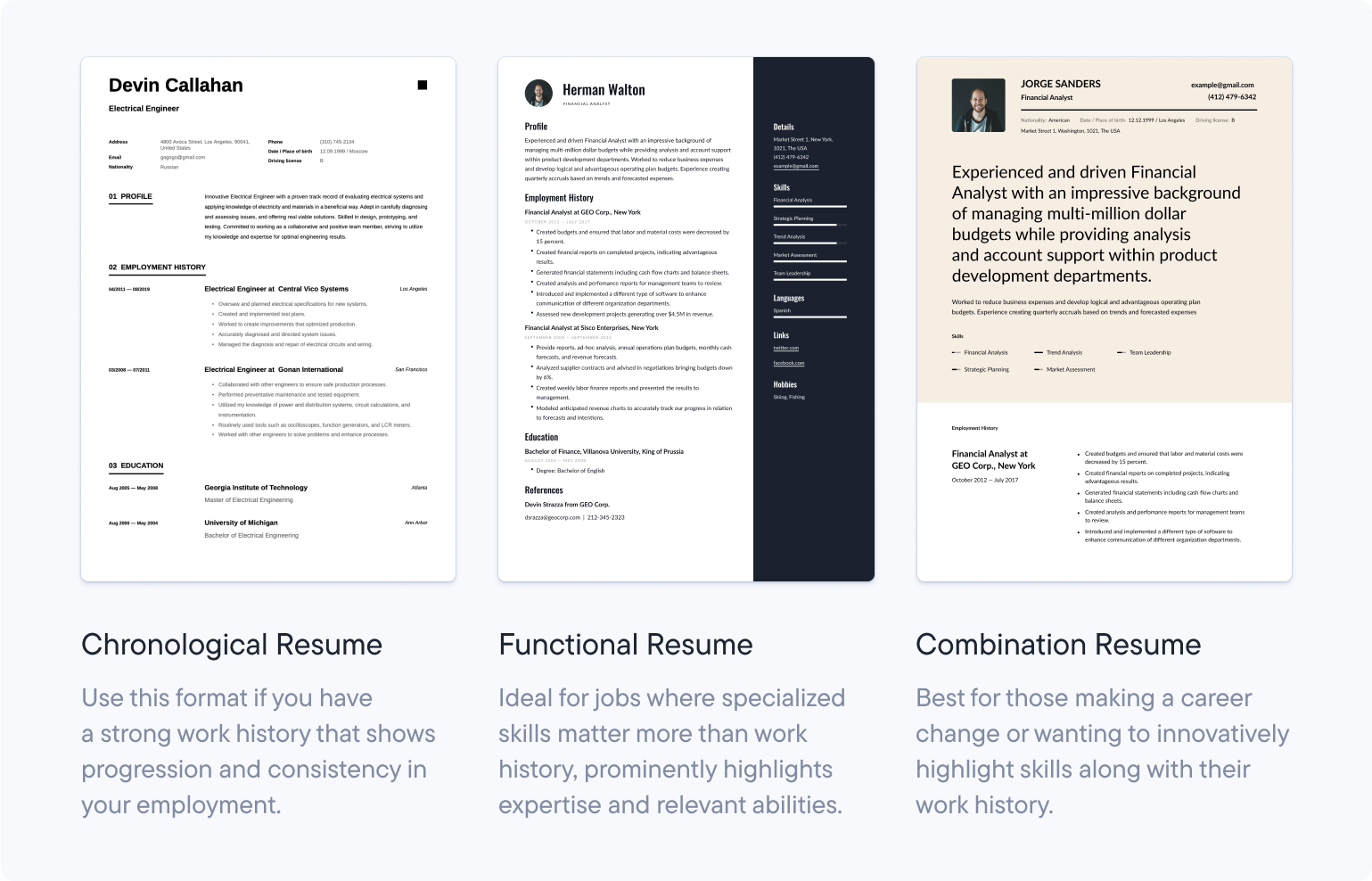
When it comes to choosing the right resume format , it’s important to think about the amount of experience you have to show, the type of job you are applying for, and the hiring manager’s expectations.
Here are three different resume sample formats to choose from:
Chronological resume format :
The chronological — also known as reverse chronological — resume format is the “standard” structure that most hiring managers will expect to see. This format focuses on the employment history section, where you can list previous positions and create bullet points that explain your key qualifications for the role. We recommend this format as the best choice for professionals and anyone with at least three previous jobs to show.
Functional resume format
The functional resume format is best-suited to students and first-time job seekers because it places less emphasis on previous experience. Instead, your resume begins with the skills section, where you can describe your key attributes and how you’ve applied those skills in other experiences.
Combination resume format
The combination, or hybrid, resume format is exactly what it sounds like — a combination of the previous two resume formats, which offers maximum flexibility when assembling your resume. This format is best suited to freelancers and other independent professionals.
Not sure which format to choose? Within our resume builder, you can create and save different versions of your resume so that the right format is always at your fingertips.
Advantages of using our resume samples for job applications
Our resume samples are designed to help today’s job seekers land their next great positions.
Our team of expert career writers take care to craft each resume sample to the field and level of experience needed for the job.
Here are just some of the reasons why our resume examples stand out above the rest:
- Expert advice: Our writing team closely monitors today’s hiring trends to make sure our resume samples are packed full of the best possible tricks and tips for your next job application.
- HR-approved layouts: Our design team works in collaboration with HR professionals to create layouts that stand out to employers and give candidates an edge in crowded applicant pools.
- Quicker and easier: Our resume samples integrate seamlessly into our resume builder , where you can easily modify your experience, change the layout, and download a perfect resume in a few clicks.
- AI sample sentences and feedback: We’ve harnessed the power of AI to create hundreds of sample sentences that can give your resume a boost no matter what industry you work in. We also provide AI-powered feedback to help you be sure your resume is ready for submission.
- Wide variety of templates: We know that different jobs require different approaches, which is why we’ve created resume templates to match roles from accountant to zookeeper – and everything in between.
- ATS-friendly Resumes : We make sure our resume samples are compatible with today’s resume scanners and ATS software. Read more about it here .
Each one of our 500+ resume examples are accompanied by a guide that provides in-depth information on how to write the best possible resume for your job title.
Our guides are 100 percent free to use, so make sure to take advantage of them and share them with other job seekers!
Resume example FAQs (Frequently Asked Questions)
What are employers’ expectations from a resume.
Employers have a few things they look for when evaluating an applicant’s resume. First, they look for a clean and organized structure. As they read the information, they make sure there are no typos or grammatical errors.
They also want to see that the applicant has a good understanding of the role and the company. Resume.io’s resume samples are designed with these criteria in mind. Our professional layouts, combined with expertly written resume samples, can help you create a perfect resume that impresses employers.
Common pitfalls to avoid in resumes
The most common pitfalls to avoid on your resume are poor formatting, spelling and grammar mistakes, a disorganized layout, and a generic resume. Luckily, Resume.io’s resume samples and templates are specifically designed to help you avoid all of these errors.
Once you’ve chosen from our hundreds of unique resume samples, open it inside of our intuitive resume builder, where you can choose a clean layout and use our AI-powered sample sentences and spell check to create a successful resume in minutes.
Do I need a cover letter to match my resume?
We recommend submitting a cover letter with your resume whenever possible in order to increase your chances of landing the position.
That’s why we offer dozens of cover letter samples and templates. To make the best possible first impression, choose a matching resume and cover letter template from our professionally-designed collections — modern, professional, simple, and creative.
Can I customize the resume example for my needs?
Yes, every one of our 300+ resume examples was designed to be modified for your own employment history and qualifications.
Just open it inside of our easy-to-use resume builder tool, where you’ll be able to change the section headings, bullet points, color, line spacing, and more. Read more about customizing your resume here .
What should I do if a specific resume example isn't available for my job?
We’re always adding new jobs and employer-specific resume samples, so there’s a good chance that your job title will be available soon.
You can also shoot us a note to let us know about a job title you’d like to see online. In the meantime, try browsing the categories to see if we currently offer a job title that’s related to yours.
Can you use the same resume example for every application?
While you can start with the same resume example as the base for every application, we highly recommend that you customize it for the job description of the role you are applying to.
This is the best way to ensure you stand out from other applicants and increase your chances of landing the position.
Visual expectations for a resume in 2024
When it comes to what hiring managers expect from the visuals of your resume in 2024, sometimes less is more. Recruiters are most concerned with being able to find the information they are looking for, so we recommend going for a clean, organized template that highlights your most impressive accomplishments.
That being said, if you work in a creative field, you may opt for a flashier resume template to showcase your personality and style.
What are the categories of resume examples?
Our resume examples are divided into broad categories, including education, government, engineering, retail, legal, maintenance and repair, administrative, human resources, real estate, sales, production, accounting & finance, business & management, security & protective services, hospitality & catering, transport & logistics, transportation, medical, information technology, sport & fitness, social work, construction, beauty & wellness, and other.
You can also browse our template categories, which are professional , modern , creative , and simple .
Are the resume examples free?
Resume.io’s resume examples and the corresponding resume guides are 100% free to view. Our resume builder comes with a free version along with tiered pricing plans. You can find out more about using Resume.io for free here.
Beautiful ready-to-use resume templates
40+ Resume Tips to Help You Land a Job in 2024

When you haven’t updated your resume in a while, it can be hard to know where to start. What experiences and accomplishments are relevant for the jobs you’ve got your eye on? What new resume rules and trends should you be following? And seriously, one page or two ?
Well, search no more: We’ve compiled all the resume tips you need into one place. Read on for advice and tricks that’ll help you craft a winning resume—and land your next job.
Maximize your chances by looking for more open jobs on The Muse »
Basic resume tips
Let's start with the basic do's and don'ts when putting your resume together. Listing your skills is not the only thing that matters—choosing the right format and sections is equally crucial. Here are some tips for writing a resume from scratch:
1. Don’t try to cram every skill and work experience onto your resume
Think of your resume not as a comprehensive list of your career history, but as a marketing document selling you as the perfect person for the role you’re applying to. For each resume you send out, you’ll want to highlight only the accomplishments and skills that are most relevant to the job at hand (even if that means you don’t include all of your experience ).
This is called tailoring your resume and it helps anyone who reads it see exactly why you’re a match for a specific position.
2. But keep a resume outline with a full list of your qualifications
Since you’ll be swapping different information in and out depending on the job you’re applying to, save a resume outline —or maybe our resume worksheet —on your computer with old positions, bullet points tailored for different applications, and special projects that only sometimes make sense to include. Think of this as your brag file. Then, when you’re crafting each resume, it’s just a matter of cutting and pasting relevant information together.
3. Ditch the objective statement
The only time an objective section makes sense is when you’re making a huge career change and need to explain from the get-go why your experience doesn’t match up with the position you’re applying to. In every other case, resume objectives just make you look old-fashioned or out of touch.
Read More: 3 Reasons You Should Ditch That Resume Objective—and 3 Things You Can Do Instead
4. Put the best, most relevant information first
In journalism speak, “above the fold” refers to what you see on the front half of a folded newspaper (or, in the digital age, before you scroll down on a website)—basically it’s your first impression of a document. In resume speak, it means you should make sure your most relevant qualifications are visible on the top third of your resume.
This top section is what the hiring manager is going to see first—and what will serve as a hook for someone to keep on reading. If your most recent position isn’t the most relevant piece of your candidacy, consider leading with a skills section (such as in a combination resume format ) or writing a resume summary .
5. Choose the right resume format for you
There are lots of different ways to organize the information on your resume—like the functional resume or combination resume. But the good old reverse chronological —where your most recent experience is listed first—is usually your best bet. Unless it’s absolutely necessary in your situation, skip the functional or skills-based resume—hiring managers might wonder what you’re hiding.
6. Keep it concise
The two-page resume is a hotly debated topic, but the bottom line is this—you want the information here to be as short as possible, and keeping it to one page forces you to prioritize what really matters. If you truly have enough relevant and important experience, training, and credentials to showcase on more than one page of your resume, then go for two. But if you can tell the same story in less space? Do it.
Read More: 6 Pro Tips for Cutting Your Resume Down to One Page
7. Include relevant links
Can’t figure out how to tell your whole story on one page, or want to be able to include some visual examples of your work? Instead of trying to have your resume cover everything, cover the most important details on that document. Then, include a link to your personal website , your online portfolio , examples of your work, or a relevant, professional social media profile , where you can dive more into what makes you the ideal candidate.
Just avoid hyperlinking over words that are key to understanding your resume, since it can throw off the tools employers use to store and parse resumes.
8. Be aware of the ATS
You may have heard that employers are using computers to “read” your resume and decide who to hire and reject. That’s not exactly true. But most employers do use software called an applicant tracking system—or ATS—to parse resumes and organize them so that recruiters and hiring managers can search for the most relevant applications.
You should assume your resume will pass through an ATS at some point during your job search, so understanding how it works will help make your hunt more efficient. (All of the tips for resume writing in this list keep ATSs in mind as well!)
Read More: Beat the Robots: How to Get Your Resume Past the System and Into Human Hands
Resume formatting tips
Your resume's format matters as much as the content it holds. Aim for a simple and minimalist layout, without overwhelming columns, colors, or graphic elements. Here are some key resume formatting tips to help you stand out:
9. Keep your resume format simple
We’ll talk about getting creative in order to stand out in a minute. But the most basic principle of good resume formatting and design? Keep it simple. Make your resume easy on hiring managers’ eyes by using a reasonably sized default font like Helvetica or Arial and leaving a healthy amount of white space on the page. Your main focus here should be on readability for the hiring manager (and that pesky ATS).
Read more: The Best Resume Font and Size (No More Agonizing!)
10. Stand out with ATS-friendly design elements
Really want your resume to stand out from the sea of Times New Roman? Yes, creative resumes —like infographics, videos, or presentations can set you apart, but you have to make sure they actually get read. If you’re uploading your resume to a job application site or online portal, use ATS-friendly formatting elements like:
- Bold and italic text
- Underlining (in headings or over hyperlinks)
- Different text alignments
- Columns that can be read straight across
11. Avoid design elements that can’t be “read” by computers
On the flip side, it’s best to avoid design elements that ATSs are known to have trouble with such as:
- Logos and icons
- Images and photos
- Graphics, graphs, or other visuals
- Headers and footers
- Less common fonts
- Columns that can only be read from top to bottom
12. Make your contact info prominent
You don’t need to include your address on your resume anymore (really!), but you do need to make sure to include a phone number and professional-sounding email address (but not one affiliated with another job!) as well as other places the hiring manager can find you on the web, like your LinkedIn profile, plus your pronouns if you’d like to.
Read More: Here's Exactly What Should Be Included in Your Resume's Header
13. Design your resume for skimmability
You’ve probably heard before that hiring managers don’t spend a lot of time on each individual resume. So help them get as much information as possible in as little time as possible, by making your resume easy to skim .
Work experience resume tips
Recruiters nowadays want to know more than a simple description of your responsibilities. They're looking for the results and impacts of your work, as well as the connection between your experience and the position you're applying for now.
That said, let's take a look at some resume writing tips for describing your work experience:
14. Keep your work experience recent and relevant
As a rule, you should only show the most recent 10-15 years of your career and only include the experiences that are relevant to the positions you’re applying to. Remember to allocate real estate on your resume according to importance. If there’s a choice between including one more college internship or going into more detail about your current role, always choose the latter (unless the internship was more relevant to the role you’re applying for).
15. Don’t forget your transferable skills and experiences
Don’t panic if you don’t have any professional experience that fits the bill. Focus your resume on your relevant and transferable skills along with any related side or academic projects , and then make sure to pair it with a strong cover letter telling the narrative of why you’re ideal for the job.
Read more: What to Put on Your Resume When You Have No Relevant Work Experience
16. Write strong, achievement-focused bullet points
The bullet points under each job entry are arguably the most important part of your resume. They tell whoever’s reading it what skills you have, how you’ve used them, and how you’ve helped your employers in the past.
So start with a strong action verb , include relevant skills from the job description , and frame your bullets around your achievements—don’t just list your job duties . Tell them how your work benefitted your boss or company so they know what they stand to gain by hiring you.
Here’s a simple formula to follow:
- Compelling verb + job duty + key skills used = tangible result
So you might say: “ Developed an upgrade to the employee database, ensuring the smooth flow of critical operations, which led to a 35% increase in efficiency. ”
17. Curate your bullet points and experiences
No matter how long you’ve been in a job, or how much you’ve accomplished there, you shouldn’t have more than eight bullet points under it—and that’s only for your most recent and relevant job. Jobs further back should generally be limited to four to six bullets.
Read More: How Many Bullet Points Should Each Job on Your Resume Have?
18. Use as many numbers as you can
Use facts, figures, and numbers whenever possible in your bullet points. How many people were impacted by your work? By what percentage did you exceed your goals? Quantifying your accomplishments allows the hiring manager to picture the level of work or responsibility you needed to achieve them.
19. Don’t neglect non-traditional work
There’s no law that says you can only put full-time or paid work on your resume. So, if you’ve volunteered , worked part-time or as a temporary or contract worker , freelanced, or interned? Absolutely list these things as their own “jobs” within your career chronology—as long as they’re relevant to the job you’re applying for. The same goes for career breaks . Yes, really.
Read More: 4 Things You Didn't Know You Could Put on Your Resume
20. Use important keywords from the job description
Scan the job description, see what words are used most often, and make sure you’ve included them in your bullet points. For example, does the job description list “CRM” or “Salesforce”? Make sure your resume matches. Not only is this a self-check that you’re targeting your resume to the job, but it’ll also make it easier to search for your resume in an ATS.
Read More: How to Pick Resume Keywords That'll Get Your Job Application Past the ATS
Resume tips for including your education
Most hiring managers will want to know your education level, even if it's not necessarily relevant to the position you're going for. This section is especially important for those changing careers or applying for entry-level jobs—as your education can be an indicator of the skills you have.
Here's some resume tips and tricks for this section:
21. Put experience first, education later
Unless you’re a recent graduate , put your education after your experience. Chances are, your last couple of jobs are more important and relevant to you getting the job than where you went to college.
22. Also keep it in reverse chronological order
Generally, you should list your educational background with the most recent or advanced degree first, working in reverse chronological order. But if older coursework is more specific to the job, list that first to grab the reviewer’s attention.
23. Remove the dates from your education section once you’re a few years into your career
Unless you’re early in your career, don’t list your graduation dates. The reviewer cares more about whether or not you have the degree than when you earned it. And you don’t want to inadvertently open yourself up to age discrimination , which is an unfortunate reality in some job markets.
24. Highlight honors and achievements, not GPA
If you graduated from college with high honors, absolutely make note of it. Showcase that summa cum laude status, the fact that you were in the honors college at your university, a relevant project you completed, or an award you won. You don’t need to list your GPA —employers don’t care as much about GPA as they do what skills you gained in school.
Read More: How to (and How Not to) List Education on Your Resume
25. Include continuing or online education
Feel free to include continuing education, professional development coursework, or online courses in your education section, especially if your resume feels a little light on relevant experience.
Best resume tips for showing off your skills
You shouldn't wait until you get an interview to showcase your skills—your resume can and should have a specific section for them. You can also leverage other sections of the document to incorporate what's relevant for the position.
Here are our tips for making a resume that effectively highlights your skills:
26. Don’t forget your skills section
Be sure to add a section that lists all the relevant skills you have for a position—especially those mentioned in the job description. Include technical skills like software and project management tools or specific knowledge of how to perform relevant tasks. Just make sure to skip including skills that everyone is expected to have, like using email or Microsoft Word. Doing so will make you seem less technologically savvy.
27. But don’t only put your skills in your skills section
Your skills section is an easy way for anyone reading your resume to confirm that you have required qualifications, but that shouldn’t be the only place that your important skills appear. Any skill that’s vital to you being hired should also be in your bullet points—where you can show how you’ve used it in the past.
28. Divvy up your skills for readability
If you have lots of skills that would help you with a job but aren’t necessarily in the same category—say, foreign language, software, and leadership skills—try breaking up your skills sections. Below your “Skills” section, add a subsection titled “Language Skills” or “Software Skills,” for example. Again, we’re going for skimmability here!
29. Show—don’t tell—your soft skills
Describing soft skills on a resume often starts to sound like a list of meaningless buzzwords. But being a “strong leader” or an “effective communicator” are important characteristics you want to get across. Think about how you can demonstrate these attributes in your bullet points without actually saying them.
Read more: The Non-Boring Way to Show Off Your Soft Skills in Your Job Search
Other resume section tips
Resume sections are not fixed like stone-written texts; they can change according to the job position you're applying for or the requirements listed by the company. Here are some examples of sections you can add—and more tips on writing a resume that stand out:
30. Include relevant certifications and licenses
If you have a certification or license that proves you can do some aspect of the job you’re applying for, include it on your resume. This is especially important if that certification or license is legally required to do the job—for example, in nursing, teaching, or driving jobs.
31. Show some (relevant) personality
Feel free to include an “Interests” section on your resume, but only add those that are relevant to the job. Are you a guitar player with your eye on a music company? Definitely include it. But if you’re considering including your scrapbooking hobby for a software developer job at a healthcare company? Best to leave it out.
32. Beware of interests and activities that could be controversial
Maybe you help raise money for your church on the reg. Or perhaps you’re dedicated to canvassing during political campaigns. Yes, these experiences show a good amount of work ethic or possibly other relevant skills—but they could also open you up to be discriminated against by someone who disagrees with the cause. So weigh your decision to include them carefully.
33. Add awards and achievements—when they’re relevant
Do include awards and accolades you’ve received, even if they’re company-specific awards. Just state what you earned them for, e.g., “Earned Golden Salesperson Award for having the company’s top sales record four quarters in a row.” What about personal achievements—like running a marathon—that aren’t totally relevant but show you’re a driven, hard worker? Consider the best way to include them (and if you should).
Resume tips for navigating employment gaps and other sticky situations
If you're an experienced professional, you might have some tricky information to explain. Job hopping, career gap, and short term jobs are examples of things that can make an applicant feel insecure when drafting resumes.
Is that your situation? Check on these good resume tips to explain sticky situations without jeopardizing your chances to get an interview:
34. Cut the short-term jobs
If you stayed at a (non-temporary) job for only a matter of months, consider eliminating it from your resume to avoid looking like a job hopper. Leaving a particularly short-lived job or two off your resume shouldn’t hurt, as long as you’re honest about your experience if asked in an interview. But if the short-term job is super relevant to this job, consider including it anyway.
35. If you have shorter gaps, be strategic about how you list dates
If you have gaps of a few months in your work history, don’t list the usual start and end dates with months and years for each position. Use years only (2018–2020), or just the number of years or months you worked at each position. Just keep it consistent throughout your resume and don’t lie if asked about gaps during an interview.
Read more: How to Explain the Gap in Your Resume With Ease
36. Explain serial job hopping
If you’ve job-hopped frequently, you can include a succinct reason for leaving next to each position like “company closed,” “layoff due to downsizing,” or “relocated to a new city.” By addressing the gaps, you’ll proactively illustrate the reason for your frequent job movement and make it less of an issue.
37. Explain a long break in jobs
Re-entering the workforce after a long hiatus? This is the perfect opportunity for a summary statement at the top, outlining your best skills and accomplishments. Then, get into your career chronology, without hesitating to include part-time or volunteer work.
38. Be intentional about career gaps
While career gaps are becoming increasingly common, you should still frame them in a way that’s relevant to a future employer, by talking about skills you gained or any professional endeavors you took on. If you didn’t focus on professional development, that’s fine too! But not every employer will appreciate it if you get too cutesy about that section of your resume.
For example, if you took time out of the workforce to raise kids, you might not want to creatively describe this parenting experience on your resume, à la “adeptly managed the growing pile of laundry.” Instead state what you did plainly and include any professional skills you may have grown or activities you may have done.
Read More: Stay-at-Home Parent? How to Kill it on Your Comeback Resume
Tips on resume finishing touches
Writing a good resume alone isn't the only thing that matters. How you save and send it can also determine whether the recruiter will even take a look at it. To wrap things up, here are our resume formatting tips and other suggestions to boost your chances of getting noticed:
39. Ditch “References available upon request”
If a hiring manager is interested in you, they’ll ask you for references—and will assume that you have them. There’s no need to address the obvious (and doing so might even make you look a little out of touch!).
40. Proofread, proofread, proofread
It should go without saying, but fully edit your resume and make sure it’s free and clear of typos. And don’t rely on spell check and grammar check alone—step away for a few hours, then read your resume closely again, and ask family or friends to take a look at it for you.
41. Save it as a PDF or Word document
Unless a job posting specifically requests that you do otherwise, your resume should always be submitted as either a PDF or Word document (.docx not .doc). These are the formats that can be most easily opened and most easily parsed by an ATS.
The choice between the two is up to you (again, unless the company you’re applying to requests one format over the other). If you’re emailing your resume, however, PDFs are a bit more likely to maintain your formatting across different computers and programs.
42. Name your file clearly
Ready to save your resume and send it off? Save it as “Jane Smith Resume” instead of “Resume.” The hiring manager is going to have plenty of “Resumes” on their computer, so make it super easy for them to find what they’re looking for. You can even go a bit further and put the position title in your file name (e.g., “Jane Smith Marketing Analyst Resume).
Read More: The (Simple) Guidelines You Should Follow When Naming Your Resume and Cover Letter Files
43. Keep your resume outline fresh
Carve out some time every quarter or so to pull up your resume outline and make some updates. Have you taken on new responsibilities? Learned new skills? Add them. When your resume is updated on a regular basis, you’re always ready to pounce when opportunity presents itself. And even if you’re not job searching, there are plenty of good reasons to keep this document in tip-top shape.
- Resume Writing
- Resume Examples
- Cover Letter
- Remote Work
- Famous Resumes
- Try Kickresume
How to Write a Resume: The Only Resume Guide You’ll Need in 2024
- Kaja Jurcisinova ,
- Updated January 16, 2024 16 min read
Your resume is arguably the most important document you'll create during a job search. So taking the time to learn how to write a resume properly can make a job hunt much quicker and easier.
What would otherwise take you hours of hard work and research can be done in a few minutes. All you have to do is follow our simple step-by-step guide on how to write the perfect resume.
In the end, a good resume gives you a chance to make a great first impression and ultimately decide if you'll be invited for an interview.
What makes a great resume?
- Clear division of resume sections
- Prioritizing relevant information
- Tailored for a specific position
- Typo-free and well-written
- Usage of bullet points
There's more to it, though.
Table of Contents
Click on a section to skip
What is a resume?
Before you start writing your resume, how to write a resume, step 1: choose the right resume format, step 2: add contact information and personal details, step 3: begin with your professional summary, step 4: list relevant work experience, step 5: summarize your education , step 6: highlight your soft and hard skills , step 7: add optional resume sections.
- Step 8: Wrap it up with a cover letter
Final tips before you click “Send”
Let's cover the basics first. Before we learn how to write a good resume, we should know what a resume even is.
The word resume comes from French, meaning “summary” . This is the perfect word because that’s exactly what a resume is: a short, straight-to-the-point summary that details your professional achievements, skills, qualifications, education, work experience, and past employers. It's also known as a curriculum vitae (CV) .
The aim of a resume is to get invited to a job interview . It should aim to convince an employer that you're a good fit for the job.
Because of that, your resume should be adjusted and tailored to each job vacancy.
TL;DR Here's a step-by-step video guide on how to write a professional resume in 2024
If you’re already familiar with what should be on your resume and just want a quick and informative recap, or if your time is limited, just check out our 5-minute step-by-step video guide .
Before we move on to how to write a resume, we recommend setting a few minutes aside for research. These few minutes can save you hours of frustration and ultimately make your job search that much easier.
Here’s what we recommend to research before you write your resume:
- Research the company, specifically the “About Us” page. This is a great place to search for keywords you can use in your resume or cover letter. What are their mission statement and their values?
- Research the position you’ll be applying for. Great resumes are tailored to a specific job opening. You can do this by asking these three questions as you go through the job post: “ What are the essential keywords? What adjectives, nouns, and phrases occur repeatedly? What language does the company use?”
- Discover your strong points , as this will make it easier to pinpoint the qualities you want to highlight in your resume. Ask people around you: “What are my skills and abilities, and what are my weaknesses?” Also, look at your past accomplishments. What were the skills and abilities that helped you succeed in the past?
Another way of preparing for writing your resume is by looking at these well-researched, specifically tailored, and properly formatted resume examples in our database. You can even filter them by your job title.
Not enough time?
Let your resume write itself. All you’ll have left to do is edit the draft.
We'll walk you through nine essential steps to help you create a standout resume.
Different resume formats cater to different types of job seekers, depending on the experience level and career goals. The three most commonly used resume formats are chronological, functional, and combination (hybrid).
Your resume should include your contact/personal information right at the top, in a so-called resume header. A resume header is more than just your name and contact details . Depending on your career path, there's a lot more that can (and should) be included in this section. To find out what to include, what to skip, and how to format it keep on reading.
A professional summary (also called resume profile or resume summary) is a short paragraph that summarizes your relevant skills, experiences, and achievements. Think of it as a teaser for the rest of your resume.
This is the most important section of your resume. You need to include key information like : names of companies, locations, job titles, positions held, dates of employment, responsibilities you've had. Then: - list the jobs in reverse-chronological order - write in bullet points - include your quantifiable achievements - avoid buzzwords - use action verbs and keywords from the job description
The education summary section, though important, varies in significance based on your career stage . As an experienced professional, prioritize work history and skills, placing education after. Keep it concise, including university, degree, and graduation year.
Skills fall into two categories: hard and soft. 1. Hard skills are teachable and measurable, acquired through training, and include computer proficiency, language abilities, project management, etc. 2. Soft skills , linked to personality traits, can enhance both work and personal life, encompassing communication, leadership, and time management, among others.
These can include: achievements and awards, certifications and licences, language skills, publications, references, hobbies, social media, volunteering, or custom sections.
A good cover letter should answer the following questions: 1. Who are you? 2. Why are you interested in working for their company? 3. Why are you the best fit for the job opening? 4. How can you enrich their company?
In the following chapters, we look at each step in more detail and give you helpful tips and examples.
Once you know what the company and job require and you’ve identified your strengths and weaknesses, you should be ready to pick the right resume format.
Make this choice depending on the stage of your career:
- Are you a seasoned professional ? Then you should pick a resume format that emphasizes your experience.
- Are you a fresh graduate? Then your resume should highlight any transferable skills you’ve acquired during your studies.
- Are you changing careers? Then a combination of the two will produce the best results.
Pick the best option for your career from the three dominant resume formats that are in use today:
- Chronological resume format. Probably the best choice for experienced professionals. Lists the candidate’s jobs and accomplishments in chronological order. Main resume section : Work Experience.
- Functional resume format. Great for fresh graduates, IT professionals, or other skill-based professions. Emphasizes skills instead of experience. Main resume section: Skills.
- Combined resume format . A combination of the previous two.
Let's take a look at what these resume formats look like in practice:
Chronological resume format
Functional resume format, combined resume format.
The resume format you choose will determine how you organize the information on your resume. It will also attract attention to some things and away from others.
Take time to understand your strengths and weaknesses and choose accordingly.
You want the recruiter to read the strongest and most relevant parts of your resume at the start. For more, check out a guide on how to choose the right resume format .
Your contact/personal information should always be at the top of your resume in a so-called resume header .
Compared to the other resume sections, filling in the contact information section may seem super easy. That's until you start asking more questions.
Should you put your address on the resume? How to include social media , and should you? And what about the date of birth?
Well, let’s see:
- Name. Absolutely necessary. Put your first name first and surname last. Middle name is optional.
- Title. Optional. If you’re applying for a position in a traditional or specialized field, it's good to add your Ph.D., MBA, or other titles to it.
- Email address. Absolutely necessary, even when you’re sending your application by email. Your email address should look professional (e.g. [email protected] , NOT [email protected] ). Always use your personal email address, not the email address with the domain of your current employer.
- Home address. Somewhat problematic. Your neighborhood can say a lot about you in some cases, disclosing living in a certain area can lead to discrimination. On the other hand, if you’re located in the same city as the company, it may help you to get the job, as it saves the company that they'd have to spend on a relocation package (of course, only if the job isn't remote).
- Phone number. Necessary. Many employers will call you by phone to arrange an interview, instead of doing it by email.
- LinkedIn. Recommended. And if you don’t have a LinkedIn profile yet, consider creating one. Make sure your profile is complete and up-to-date.
- Social media. Optional. Include it only if it’s related to your job. GitHub, Behance, and even your Facebook or Instagram profile will do (if you regularly post content that has to do with your profession). Here are a few tips on how to include your social media .
- Blog/website. Optional. Similar to social media. If you have a blog , website, or digital portfolio related to your chosen profession, don’t be afraid to show it off.
- Photo. Problematic. It depends on the country. In most English-speaking countries, they don’t add a photo. See this guide to know if you should put a picture on your resume .
Your professional summary should be a list of about 4-5 bullet points or a short paragraph that summarizes your relevant skills, experiences, and achievements.
You can think of it as a teaser for the rest of your resume. Make sure it’s interesting enough to hook the hiring manager right in.
But how do you write a good professional summary?
- Write your professional summary last. It’s surprisingly easy to do if you’ve already finished other sections of your resume.
- The first bullet point should describe your professional title. Don’t forget to add the number of years of experience. Write it in bold if the number is especially impressive.
- Pick the most impressive parts of your resume and rewrite them into snappy bullet points. Tease your potential employer into reading further.
- Pack your professional summary with relevant keywords. Think of ATS. This will help you get through automated pre-screenings.
- Quantify every achievement if possible. This will make you look even more professional.
- Tie every bullet point to the requirements introduced in the job offer.
If you do everything right, you should end up with something like this:
The work experience section is what most people picture when they think “resume” .
The trick is to focus on your past achievements , not your responsibilities.
Hiring managers are likely to know what your responsibilities were supposed to be. In most cases, your job title says it all.
If you want to stand out, you should tell them how you excelled in your previous job instead.
And there’s hardly a more effective way to do that than by mentioning your achievements.
But how do you list your work experience on a resume?
- Put your work experience section in the right spot. If you can boast a lot of professional experience, put your work experience section right under your resume summary. If you don’t have enough experience yet, put it just below your education section. Finally, if you prefer to highlight your skills instead of experience, put your skills section first.
- Give it a proper heading. Keep it simple and stick to “Work Experience” or “Employment History” as other headings might not be understood by applicant tracking systems (ATS) .
- List your jobs in reverse-chronological order. Start with your most recent experience and work your way back from there. Based on your level of experience, decide how far back should your resume go .
- Don’t include the job description. Instead of listing what you were supposed to do, try to tell your potential employers what positive results you had.
- Write in past tense. This will help you focus on your past achievements instead of responsibilities. It also sounds better.
- Show your problem-solving skills. In the end, hiring managers want to know how effective you’re going to be in solving real problems. There’s no better way to show your problem-solving ability than to briefly describe how you solved difficult problems in the past. Follow the PAR scheme: What was the (P)roblem? What (A)ction did you take? What was the (R)esult?
- Quantify results. Hiring managers love measurable results. Because of that, a single number often speaks more than a thousand words. Don’t say that you “increased the company’s revenue significantly.” Instead, don’t be afraid to brag about “increasing the company’s revenue by 20%.”
- Use bullet points. Bullet points help you structure each subsection. Try to limit yourself to about 5 bullets per job.
- Avoid buzzwords. People used some phrases in their resumes so much, these words have become meaningless. Everybody seems to be an out-of-the-box creative thinker with a knack for innovation nowadays. But in reality, only very few people really are those things. See what other 10 buzzwords you should stop using on your resume
- Use action verbs . Unlike buzzwords, action verbs carry the weight you need to persuade an employer to hire you. Just to mention a few, these are words like “developed” , “increased” , “facilitated” and others. For more action verbs, check out our resume cheat sheet .
- Keywords. Reread the job description and carefully pick the most important keywords. These are the words that best describe the position you’re applying for, and that will attract the attention of the ATS system.
In the end, your work experience section should look a bit like this:
The education summary section is where you list your degrees and relevant academic accomplishments.
Based on your degree and where you're in your career, it can be either the least or the most important part of your resume.
Are you an experienced professional?
Once you become more experienced, the education section takes a back seat to your work history and hard skills.
In other words, your education section should come after your work experience section, not the other way around. It also shouldn't be too long. For instance, your grades are no longer relevant.
It’s enough if you include the name of your university, the name of your degree, and the year you graduated.
Here’s an example:
Are you a fresh graduate?
Then your degree is still one of the strongest cards you have to play.
In practical terms, it means that you should place your education section at the top of your resume — right between your professional summary and work experience section.
It should also be a bit longer.
These are the things you should add to your education section if you’re a student or a fresh graduate:
- Academic awards. AP scholar, Duke of Edinburgh award, National Merit Award, President’s Award, school subject-based awards, dean’s list, etc.
- Scholarships. Athletic scholarships, scholarships for women, creative scholarships, etc.
- Academic conferences and symposia. Don’t forget to mention the scope and name of the paper you presented at a conference.
- Relevant student societies. Debating or programming clubs. If you were on a student committee of any kind, mention that too.
- GPA. Only include your GPA if it was higher than 3.0 on a 4.0 scale. If your overall GPA was lower, mention your overall GPA. Alternatively, mention your summa cum laude or magna cum laude .
- Academic publications. Producing an academic work worth publishing is impressive no matter the context.
In the end, your education section can look like this:
Before you start writing, you should know there are two types of skills : hard skills and soft skills.
1. Hard skills can be learned, taught, and most importantly — measured. Acquiring them requires deliberate effort, training, and time.
Hard skills can be, for instance: computer skills, language skills, manual skills, mathematics, project management, etc.
2. Soft skills are tied to your personality traits. These skills can come as part of your upbringing, or you can acquire some later in life through self-improvement. These skills can bring value to any job, as well as your private life.
Examples of soft skills include: communication, leadership, time management , creativity, decision-making, etc.
But how to make your skills stand out?
- Focus on what’s most relevant. Do you have any of the skills mentioned in the advertisement for your desired job? Good. Make sure to include them in your resume’s skills section.
- Organize your skills into subcategories. Divide your skills section into several subsections like computer skills, soft skills, languages, and others.
- Don’t underestimate soft skills. 67 percent of HR managers said they’d hire a candidate with strong soft skills even if their technical abilities were lacking. On the contrary, only 9 percent would hire someone with strong technical credentials but weak soft skills.
- There are skills you shouldn’t include. Never include any skills you don’t have, skills that have nothing to do with the job, skills everybody should have, or skills that have become obsolete.
Apart from the standard resume sections we just mentioned above, are also optional sections.
A good rule of thumb is to add an optional section only if it's relevant to the job you're applying for. If done properly, these sections can help you:
- Fill the gap when lacking experience
- Highlight additional skills and expertise
- Let an employer know more about who you are
Pro tip: Optional resume sections can be especially important to companies that prioritize hiring candidates who fit their workplace culture.
Here are some of the most common optional sections:
Technical skills
This section can be a nice addition when applying for (surprise!) technical jobs.
Some examples of technical skills are: programming languages, software proficiency, project management, and data analysis.
Technical skills are usually measurable, so if you decide to include them in your resume, use a graph or a scale to illustrate how strong they are. Adding visual elements to your resume not only looks nice but also shows your ability to be precise and analytical.
Achievements and awards
Scholarships, competitions, work-related awards, or even promotions to leadership positions in your job — all of these can be considered important professional achievements.
Either distribute them across other parts of your resume or put them in a dedicated section. The latter allows you to truly highlighted them.
And if you choose to include them in a separate resume section, don't forget to mention the dates and the name of the company/institution at which you've accomplished the achievement.
Professional references
In today's competitive job market, strong professional references can be a game-changer. Consider including a ' Professional References ' section in your resume to provide potential employers with easy access to these valuable resources.
How to format references on resume? Here's what you should list for each reference:
- Their full name
- Their current job title and organization
- Their contact details (email and phone number will do)
- Your relationship with them (e.g., Former Supervisor)
Ensure you have their permission and inform them when actively job searching.
Once you decide who you want your references to be, it's time to ask them if they agree. Here's how to ask someone to be a reference via email .
Certifications and licenses
Listing the certificates and courses that you've successfully completed on your resume is never a mistake.
However, keep in mind that they should be related to the role that you're applying for.
If you'd like to add a certificate to your CV but you're unsure about where to find the best course for you, check out this carefully curated list of the best online courses that will help you to get a job.
Publications
In this section, you can mention all the relevant conferences, presentations, and written publications.
This section is most useful if you're working in academia, marketing, or journalism.
However, include it in your resume also if you're applying for a position that requires you to be an expert on the topic that you've written about.
Volunteering
This section lists your volunteer work . It should be treated similarly to a work experience section. The reason is that whether your work was paid or not, it still translates to real-life experience.
This is true especially if you find yourself at the beginning of your career. In that case, feel free to place the volunteering section towards the start of your resume.
On the other hand, if you're a seasoned professional, locate this section more toward the end of your document.
This is the part of your resume that's the most personal. Here, let a little loose and let your personality shine through. List you hobbies and interests, even the quirky or unique ones.
Hobbies serve as a great way for a hiring manager to see you more as a person and less as just a name written on a paper. They can also break the ice during the interview stage.
Christy's word of advice
Really, it sounds so simple, but one of the best ways to stand out with your resume is to apply for jobs you’re a close fit for. So many people apply ‘just in case they’ll consider me if even I only meet some of the requirements’, then feel deflated when they’re rejected. The company has spent time figuring out exactly what they need and are paying their staff or a recruiter to find that. Look closely at the minimum/essential requirements, apply for jobs you’re a great fit for, and you’ll have much better luck!
Christy Morgan, Resident HR Expert
Step 8: Wrap it up with a cover letter
Phew! Almost done with how to write a resume. Just a little bit of editing and proofreading, picking the right resume template , and you should be able to click send, right?
Well, not quite. At least we wouldn’t recommend you sending it — yet.
The truth is that resumes are often put aside when not accompanied by a cover letter. It would be a shame if this happened to you, especially after all the time you’ve spent creating it.
A good cover letter is a way to stand apart from the competition. It’s where you can show your hiring manager you mean business.
And, if you're fresh out of college or changing career this step-by-step guide on how to write a cover letter with no experience will show you what to focus on instead.
Here are 4 questions to guide you while writing your cover letter:
- Who are you (professionally)?
- Why are you interested in working for their company?
- Why are you the best fit for the job opening?
- How can you enrich their company?
When all it’s said and done, your cover letter should look something like this:
Cover letter example
This cover letter sample was provided by a real person who got hired with Kickresume’s help.
Want more inspo? Browse another 1,250+ cover letter examples by your profession.
And if you really want a memorable cover letter, we’ve got you covered. In fact, we’re certain it will be the only cover letter guide you’ll ever need .
- The older the job, the fewer the details. In other words, don’t have 13 bullet points on a job from 5 years ago.
- Use off-peak hours for maximum attention , especially if you’re reaching out to an employer directly. Hiring managers are busy people and you want them to receive your resume when they have enough time to carefully read through it.
- Check your resume for typos. If English isn't your first language, employers might be inclined to overlook any grammatical mistakes that you make in your resume. Typos, on the other hand, are unforgivable. Your computer’s spell-check feature can help you fix that.
- Customize your resume for each job application. Every employer is different. And any hiring manager can tell if you’ve just sent them the same generic resume as to everyone else. So make sure you tailor your resume to each individual employer to increase your chances of getting hired.
- Get the introductory email right. It doesn’t matter that you have the best resume ever if nobody gets to read it. Attach it to an email that catches the employer’s attention from the get-go. Pay particular attention to the subject line that will make them read the full email, including the attachments.
FAQ: How to write a resume
One to two pages is the ideal. If you're at the junior stage of your career, one page is more than enough. Similarly, make sure that your resume isn't longer than three pages (and this may be stretching it already), even if you're a CEO.
Generally speaking, content is superior to form when it comes to resumes. However, a nice design is the first thing that catches the recruiter's attention — and that's precisely what you want. Moreover, if you're looking for a job in marketing, art, or design, the design of your resume naturally becomes your selling point, too.
Typos, being too general and not specific enough, not including relevant information, not using action verbs, and writing about duties instead of accomplishments.
The best format for sending a resume is PDF, as it keeps the visuals of the resume unchanged once the document is opened by the recruiter.
1. Include standard resume sections. Contact information, resume summary, work experience, education, skills. 2. Include optional resume sections. Awards, references, certifications, publications, projects, etc. 3. Choose a resume format. The three standard are: chronological, functional, combination. 4. Use bullet points. Use bullet points to make your resume easier to scan and highlight important information quickly. 6. Think about the margins . Strike a good balance between not leaving too much white space and making your resume seem cluttered. 7. Keep it to one-two pages . Unless you have extensive work experience, you should generally aim to keep your resume to one page. 8. Consistency is key. In all aspects of your resume, including the spacing, font, margins, etc. 9. Use a professional resume template or layout which helps to structure the information effectively and makes it easy to read.
Good job, you made it! If you still need more information on how to write a resume. You can go further in-depth in our section-by-section resume guide .
This article was recently updated. The original article was written by Noel Rojo in 2019.
Kaja Jurcisinova is a junior copywriter at Kickresume. Kaja completed her undergraduate degree in Art History at the University of St Andrews in 2018 and graduated with a Master’s in Arts and Culture from the University of Groningen in 2021. She was an intern at multiple cultural institutions across Europe, including the Dutch Museum Association in Amsterdam, the Matter of Art Biennale in Prague, and the European Cultural Centre in Venice. At the moment, she resides in Visby on the Swedish island of Gotland.
Related Posts
Resume headings: use these headlines in your cv to beat the ats game, skills-based resume: how to write it & why you need it (+resume examples).
- 13 min read
Share this article
Join our newsletter.
Every month, we’ll send you resume advice, job search tips, career hacks and more in pithy, bite-sized chunks. Sounds good?
How to Write a Resume for Today’s Job Market
To get more job interviews, you must create a resume that is optimized for applicant tracking systems (ATS). Learn how in this step-by-step guide.
Customers Interviewed by:
Learning how to write a resume is a crucial skill for job seekers—it’s how you market yourself to potential employers.
A well-crafted resume summarizes your professional experience, skills, and achievements. It should grab the hiring manager’s attention and show them them why:
- You’re the perfect match for the job.
- The skills you have will make the company money.
- You’re qualified to solve the company’s problems.
- You’ll be worth your salary.
- Your accomplishments can be measured and verified.
But in today’s job market, it’s not enough to write an effective resume. You must also tailor each one to the job you’re applying for. Why? Because most companies today use applicant tracking systems, or ATS, to sort and filter the large volume of resumes they receive.
If you’re resume doesn’t contain the specific keywords hiring managers are searching for, it won’t be found—even if you’re qualified for the job!
In this guide, you’ll learn how to write a resume that stands out in today’s job market. We’ll show you how to present yourself as the ideal candidate, highlight the skills that will benefit potential employers, and ensure your resume is compatible with ATS.

How to write a resume that gets interviews
Here’s a quick overview of the basic steps for writing a professional resume. Follow these steps to make your resume clear, concise, and appealing.
Gather all relevant data about your work experience, skills, achievements, and education.
Select a format that’s right for you, whether it’s chronological, functional, or hybrid., clearly list your name, phone number, email, and key social media profiles., create a compelling headline that includes the job title you’re applying for., write a brief statement that summarizes your key achievements and value you offer., list the skills you have that align closely with the job requirements., detail your past job roles, responsibilities, and accomplishments., include your educational degrees, certifications, and relevant training., showcase any relevant honors, awards, and volunteer work., tailor your resume by focusing on the experiences and skills that are most relevant to the job..
Before you start working on your resume, remember that your resume is not your biography. You’re not telling the story of your life. Instead, your resume should be a targeted document meant to showcase the skills and experiences that match the job you want .
This means that if something is not relevant to your targeted job, leave it out . With this in mind, let’s start building your resume!
1. Gather your essential information before you start
Before diving into the actual resume writing, it’s crucial to collect all the necessary information you’ll need. This preparatory step ensures that the resume writing process is smooth and that you don’t miss any important details.
- Significant achievements : List standout accomplishments from previous roles that demonstrate your contributions and successes.
- Skills : Compile a list of your soft, hard, and technical skills that align with those required by the job you’re targeting.
- Employment history : Provide detailed information about past employers, including their names, your dates of employment, locations, job titles, and a clear description of your duties.
- Education : Document your academic qualifications like college degrees, certifications, or licenses that prove your expertise in relevant fields.
- Volunteer work : Include any voluntary engagements where you developed skills pertinent to the job you are seeking.
- Awards and honors : Mention any notable recognitions you’ve received that underscore your exceptional talents and commitment.
When you gather your information, include everything you can think of. You can cut information that’s not relevant to a specific job later.
2. Choose a resume format that’s right for you
A resume format is the way you organize, or lay out, your information. There is no one-size fits all resume format. Instead, there are three different types of formats to choose from – chronological, functional, and hybrid. Which format you choose depends on your particular situation.
The chronological resume format
This is the most traditional resume format, especially for job seekers with lots of relevant experience.
The chronological resume format lists your work history in reverse chronological order , with your most recent jobs listed first. Your skills and education should come after your work history in this format.
- Have a strong work history showing steady career growth without significant employment gaps.
- Are staying in the same field and want to highlight your experience and advancements within that field.
- Want to highlight career progression and professional achievements over time.
The functional resume format
This resume format focuses on your skills rather than your work history. It helps you downplay your lack of experience in a particular field.
In this format, your skills and education should be emphasized over your work history.
- Are changing careers and want to emphasize transferable skills over past job titles.
- Have gaps in employment and want to focus on skills rather than work experience.
- Are new to the workforce and want to highlight skills, coursework, and internships.
NOTE : Generally speaking, we don’t recommend the functional resume format . Recruiters want to see some kind of work history. Instead of the functional format, try the next resume format—the hybrid.
The hybrid resume format
A hybrid resume is a combination of the chronological resume and the functional resume. It showcases both your work history and your skills.
In this format, your skills comes before your work history. But your work history is still the heart of your resume, just like in the chronological format.
- Have lots of skills that are relevant to the job you are targeting.
- Are climbing the career ladder within the same field.
- Are changing roles within the same industry and want to highlight your relevant skills.
We like the hybrid resume because it offers the best of both worlds, combining the strengths of the chronological and the functional resume formats.

3. Put your contact information at the top of your resume
This section might appear simple, but it’s important. If hiring managers can’t contact you, you won’t get an interview.
- Phone number
- Location (City, State, Zip Code)
- Email Address
- LinkedIn profile URL
It’s surprising how often job seekers forget a crucial piece of contact information. Double-check to make sure it’s as easy as possible for recruiters to contact you for a job interview.
Here’s an example:

Contact information do’s and don’ts
- Include your full name, including your middle initial.
- Include a link to your professional website or online portfolio.
- Create a strong LinkedIn profile and be sure to include the URL on your resume.
- Don’t write your full address; only your city, state, and zip code.
- Don’t include a work phone number; only your personal number.
- Don’t add a photo of yourself . This can lead to bias or discrimination.
4. Create a compelling resume headline
Your resume headline comes right after your contact information. At the very least, your headline should clearly identify the title of the job you’re applying for.
Is putting the job title in the headline necessary? Yes! “Think of your resume as a maze,” says resume expert Laura DeCarlo . “It has to have a visible entrance or no one would ever get started.” Without a headline, “the prospective employer won’t know for which position you are applying.”
Your headline can also include years of experience and key qualifications. Here’s an example:


Resume headline do’s and don’ts
- Tailor your headline to each job you apply for.
- Keep your headline under ten words to make sure it packs a punch.
- Position yourself as an expert in your field.
- Don’t use clichés such as “hard worker” or “team player.” Be specific.
- Don’t be too salesy. Focus on giving a snapshot of your skills and experience.
- Don’t make your headline too long. Cut to the chase.
5. Write your resume summary
A resume summary is a brief paragraph that provides an overview of your qualifications for the role you’re applying for. Most expert resume writers today highly recommend using a summary.
“One of the most common mistakes I see in resumes is the absence of a targeted introductory paragraph at the beginning of the resume,” says career coach Suzanne Berger . “Keep in mind that recruiters or hiring managers only spend 10 to 20 seconds reviewing your resume, so it is important to make an impact from the start.”
As you can see from the following example, your summary goes right under your resume headline:

Your resume summary should include a concise overview of your key qualifications, professional achievements, and skills that are relevant to the job you are applying for.
Here’s a formula you can use to write your summary, followed by an example:
[Your Professional Title] with [Years of Experience] years of experience. Proven track record in [Top Achievement 1] and [Top Achievement 2] . Skilled in [Skill 1] , [Skill 2] , and [Skill 3] . Known for [Unique Value or Strength] .
Marketing Manager with 8 years of experience . Proven track record in increasing online engagement by 40% and boosting lead generation by 30% . Skilled in content creation, data analysis, and strategic planning . Known for exceptional organizational skills and the ability to manage and inspire teams to exceed corporate objectives .
Resume summary do’s and don’ts
- Use numbers to show that you are able to produce tangible outcomes.
- Incorporate keywords from the job description whenever possible.
- Write your resume summary last because you’ll then have a fuller picture of your experiences and skills.
- Don’t just list your job duties; instead focus on your accomplishments.
- Don’t use personal pronouns (I, me, or my).
- Don’t make your summary too long; keep it to no more than 3-4 sentences.
6. Create your skills section
When we talk about keywords, we are mostly talking about skills .
There are two main types of skills— hard and soft . Hard skills are specific abilities you learn through education or training, like using certain software or speaking a foreign language. Soft skills are more about how you work and interact with others, such as teamwork, communication , and flexibility.

You should place your skills section under your resume summary. List your skill set using bullet points, either in columns or in a bullet-point format. Try to include 10 to 20 key skills in this section.

IMPORTANT! The way the same skill is worded in a job description can vary from company to company. This is why it’s crucial to tailor each resume to the job you’re applying to.
For example, here are three different ways of listing essentially the same skill:
- Customer Service
- Client Relations
- Customer Support
If the job description lists “customer support” and you have “customer service” on your resume, the hiring manager might not find your resume when searching through the ATS database — even though you do have that skill.
To make sure you’re using the right keyword skills, run your resume through Jobscan’s resume scanner . It compares your resume to the job description and tells you which skills to use.
You’ll also receive a resume score which tells you how closely your resume matches the job description. The higher your score the more likely you are to get an interview. Here’s an example of the report you’ll receive from the resume scanner:

The skills in red are missing from the resume. Add them to increase the resume score. You can read more about Jobscan’s resume scanner and how to try it for free here .
7. Create a compelling work history section
Now it’s time to get to the heart of your resume – the work experience section. This is the section employers will spend the most time looking at when they consider your resume.
Why is this section so critical? Because it’s where you provide the proof to support what you said about yourself in your resume headline, summary, and skills section.
Each job should include the following information and be listed in reverse-chronological order (latest job first).
- Company name and location – Include the full name of the company you worked for followed by the city and state of its location.
- Job title – Be as specific as possible to ensure that employers know exactly what your role was within the company.
- Start and end dates – Include the month and year for each position. If you only list the year, it may appear as though you are omitting information.
- Achievements and responsibilities – These can be listed using bullet points. Include hard numbers and metrics wherever possible.
One of the biggest mistakes people make when writing a resume is only listing their job responsibilities. These are tasks that you’re expected to perform as part of your job.
Listing your job responsibilities gives a potential employer an idea of what you did day-to-day. But it doesn’t reveal how well you did it.
This is why it’s important to highlight your specific accomplishments. For example, if you increased sales, reduced costs, or implemented new processes or technologies, be sure to mention these accomplishments.
Here’s an example of a work experience section with measurable achievements :

To write strong bullet points for your work experience section, use Jobscan’s AI-powered bullet point generator. It creates bullet points based on the skills in the job description, highlighting your relevant qualifications. Try it for free here .
Work experience do’s and don’ts
- Use numbers to quantify your achievements whenever possible.
- Use action verbs to describe how you did something.
- Use the mm/yyyy format for resume dates .
- Don’t list more than 10 years of work experience unless it’s highly relevant.
- Don’t use the passive phrase “responsible for.” Instead, use active voice.
- Don’t list every single task you worked on; include only the most relevant.
8. Create your education and certification section
Your education section should appear after your work experience. If you’re applying to a job that requires extensive education (like medicine, law, or academia), you’ll need to be more detailed. But most job seekers can get away with providing only the following information on their resume:
- Name of the degree/certification: Write the full name of the degree or certification. Use commonly accepted abbreviations (e.g., B.A. in English, MBA, PMP).
- Institution name: Include the name of the university or institution that awarded the degree or certification.
- Location (optional): List the city and state if the location is relevant to the job or if the institution is well-known.
- Graduation date: Mention the month and year of graduation. For certifications, you can also include an expiration date if applicable.
Here’s an example of an education section on a resume:

Education section do’s and don’ts
- Bold your degree so that it stands out.
- List your education in reverse-chronological order.
- Include any relevant coursework, skills training, licenses, and certifications .
- Don’t mention your high school if you have a college degree.
- Don’t disclose your GPA unless you graduated recently and had a very impressive academic career (3.5 GPA plus).
- Don’t list an advanced degree if the job doesn’t require it.
9. Showcase honors, awards, and volunteer work
The key to this section is to only include honors and awards that are relevant to the job you’re applying to.
This can get a little tricky because if you do have honors or awards that are highly relevant, consider including them in your summary section. Otherwise, hiring managers might miss them if you only list them at the bottom of your resume.
If you have any volunteer experience , it’s generally a good idea to add it to your resume.
According to a LinkedIn survey , 20% of employers say they have hired a candidate because of their volunteer experience. The survey also showed that job seekers who volunteer are 27% more likely to be hired than non-volunteers!
- The name of the organization.
- The dates of your service.
- A brief description of your duties and responsibilities.
Here’s an example of what this section of your resume can look like:

10. How can you tailor your resume to a specific job position?
Tailoring your resume to each specific job is not just recommended; it’s imperative . This is because most companies today use ATS computer software to manage and filter the enormous amount of resumes they receive.
When you submit your resume, it goes into an ATS database . Hiring managers search the ATS database for suitable resumes by typing keywords, or skills, into the ATS search bar. If your resume contains these keywords it will be found. If it doesn’t contain the right keywords, your resume will remain in the ATS database, unseen.

To tailor your resume, you must first read the job description. This is where you’ll find the keywords to add to your resume. Make sure you add those keywords exactly as they are written in the job description .
Unfortunately, tailoring each resume to the job description takes time and effort. The best way to speed up this process is to use an online tool like Jobscan’s resume scanner .
Just paste in your resume and the job description and click scan. You’ll receive a match report telling you how closely your resume matches the job ad. The report also tells you exactly which keywords to add to your resume to optimize it for the ATS. Try the scanner for free below:
Effective resume formatting tips
Properly formatting your resume makes it easy for hiring managers to find what they’re looking for. At the same time, good formatting helps the ATS understand your resume.
Remember, if the ATS can’t read your resume you won’t get the job!
Choose a professional, easy-to-read font like Arial, Calibri, or Times New Roman in size 10 to 12 for text and 14 to 16 for headings.
Clearly distinguish section headings with a larger font size, bold text, or underlining to guide the reader’s eye effectively through your resume., set your margins to at least 0.7 inches all around, ensuring that your resume looks balanced and does not appear overcrowded., avoid complex graphics, tables, headers, and footers, which can confuse ats software., break up blocks of text. a paragraph should never be longer than 5 lines., use standard headings like “work experience,” “education,” and “skills.” these are immediately recognizable to both hiring managers and ats., use the same style of bullets, text alignment, and line spacing throughout your document., align your text to the left. right-aligned or justified text can create irregular spacing between words, making your resume harder to read., save your resume file as a pdf to preserve your formatting across different platforms., proofread carefully one grammatical error can ruin your chances of getting a job., how to write a resume for students with no experience.
Creating a good resume without any work experience might seem tough, but you can still make a strong impression on employers by highlighting your skills and activities. Here’s how:
- Focus on your education : Put your education section at the top. Include details like your degree, major, relevant coursework, academic honors, and GPA if it’s above average.
- Include extracurricular activities : List any activities outside of class, like clubs, sports, or student government. Mention any leadership roles or responsibilities you’ve had.
- Add volunteer work and internships : Don’t forget to include volunteer positions, internships, or community service. These experiences show your willingness to work and learn.
- Highlight projects and academic achievements : Talk about any major projects or research you’ve done, especially if they relate to the job you want. Describe what you did and what you achieved.
- Skills section : Make a list of your skills, including technical skills (like computer software) and soft skills (like teamwork and communication).
- Professional summary : Start with a short summary that explains your career goals and your best qualities. Make it clear why you’d be a great fit for the job.
Here’s a sample of a resume for students with no experience:

How to match your cover letter to your resume
Matching your cover letter with your resume helps create a polished and cohesive application. Here’s how:
- Consistent formatting : Use the same font, header, and layout from your resume for your cover letter. This helps create a professional and unified appearance.
- Use similar language : Pick out key skills and phrases from your resume and include them in your cover letter. This reinforces your qualifications and aligns your application with the job requirements.
- Expand on key points : Choose one or two major achievements listed on your resume and elaborate on them in your cover letter. Explain how these experiences have equipped you for the job.
- Keep the tone the same : If your resume is formal, your cover letter should be too. If it’s more casual, your cover letter can be less formal as well.
- Address the job’s needs : Demonstrate how your experiences make you a good fit for the job. Show that you understand what the job involves and explain why you’re the right candidate.
- End with a call to action : Conclude by expressing your enthusiasm for the role and suggesting they look at your resume for more details. Ask them to contact you for an interview.
When you’re done writing your cover letter, run it through Jobscan’s cover letter checker . This tool will tell you how to improve your cover letter.
Hate writing cover letters? Use Jobscan’s cover letter builder . This tool uses AI technology to generate an ATS-friendly cover letter with just one click.
10 standout resume examples to inspire you
These samples showcase a variety of styles and formats suited for different industries and career stages, giving you ideas on how to write a resume.
1. Sales manager resume example

2. Accountant resume example

3. Recruiter resume example

4. Bookkeeper resume sample

5. Digital marketing resume example

6. Teacher resume example

7. Customer service resume example

8. Office assistant resume example

9. Operations manager resume example

10. Technical writer resume example

Key takeaways
- Optimize for ATS : Today’s resumes must be tailored to pass through Applicant Tracking Systems (ATS) by including specific keywords related to the job you’re applying for. This ensures your resume is seen by hiring managers.
- Tailored Resumes : Each resume should be customized to the job description, emphasizing relevant experiences and skills. This enhances your chances of standing out in a competitive job market.
- Resume Formats : Choose between chronological, functional, or hybrid formats based on your career history and the job requirements. Chronological is suitable for those with a strong, relevant job history; functional is best for career changers or those with gaps in employment; hybrid combines the strengths of both.
- Essential Elements : A resume should include a clear headline, a compelling summary, a detailed work history, relevant skills, and educational credentials. Each section should be crafted to showcase your qualifications and fit for the role.
- Skills and Keywords : Highlight both hard and soft skills that are directly relevant to the job. Using precise keywords from the job description in your resume ensures compatibility with ATS and increases the likelihood of your resume being selected.
- Quantifiable Achievements : Where possible, use metrics to quantify your accomplishments. This provides concrete evidence of your capabilities and impact in previous roles.
- Additional Sections : Including volunteer work, awards, and certifications can differentiate your resume. Ensure these are relevant to the job to keep the resume focused and impactful.
- Resume Building Tools : Utilize tools like resume builders and scanners (e.g., Jobscan) to construct a resume that matches job descriptions and optimizes for ATS, saving time and improving effectiveness.
- Format and Proofread : Proper formatting and thorough proofreading are essential to maintain professionalism. Ensure the resume is easy to read and free from errors, which can detract from your credibility.
Beginners can use the chronological format if they have some work experience, even if it’s part-time jobs, internships, or volunteer work. However, if a beginner has little to no work experience, a functional format might be better. Include essential resume sections like contact information, a summary, education, and any relevant work experience or skills. Tailor your resume to the job by incorporating keywords from the job description. If you lack work experience, emphasize volunteer work, internships, and extracurricular activities that demonstrate your skills and commitment. Always proofread for errors before submitting your resume.
To make your resume stand out to recruiters, start by tailoring it specifically for each job application, incorporating keywords from the job description to align closely with the requirements. Highlight your achievements by quantifying them with specific numbers and outcomes, such as “increased sales by 20%” or “reduced processing time by 30%,” to demonstrate measurable success. Begin with a compelling professional summary that succinctly outlines your key qualifications and what you bring to the role, clearly establishing why you are the ideal candidate. Ensure your resume has a clean and professional layout, with logical sections and easy-to-read fonts, to facilitate quick review and make a strong first impression.
1) Gather information 2) Choose a format 3) Write contact information 4) Craft a headline and summary 5) Detail your experience and education 6) Highlight skills 7) Add additional sections 8) Tailor for the job 9) Proofread and edit 10) Finalize and save
To create a resume with no work experience , start with a functional format that emphasizes your skills and education. Begin with a strong summary statement that highlights your career goals and key skills. Place your education section prominently, including any relevant coursework or projects. List both hard and soft skills applicable to the job, and include any internships, volunteer work, or extracurricular activities that demonstrate your abilities and work ethic. Mention any significant projects or achievements, especially those relevant to your desired job. Also, include any professional affiliations that show your interest in the industry. Ensure the resume is well-organized and clearly formatted to highlight your qualifications effectively.
Use Jobscan’s resume builder , which is specifically designed to help you craft an AI resume that is both appealing to hiring managers and optimized for Applicant Tracking Systems (ATS). This tool provides templates and real-time content suggestions, helping you tailor your resume effectively for each job application. You can also use ChatGPT to write a resume for free . Just be sure to edit and personalize the results you get.
1) Log into your Google account, go to Google Docs, and either start a new document or use the template gallery. Jobscan also offers free Google Docs resume templates . 2) Select a resume template that fits the job you’re applying for from the template gallery. 3) Replace the template’s placeholder text with your personal information, including contact details, educational background, work experience, and skills. 4) Tailor the content to the job by adding relevant keywords from the job description and adjusting the format—like fonts and spacing—for clarity and appeal. 5) Double-check your resume for any errors and consider having someone else review it too. 6) Once satisfied, download your resume as a PDF or DOCX file , or share it directly via email or a shareable link.
1) Start the program and select “New” from the file menu to access templates. 2) Type “resume” in the template search bar to see available resume designs. 3) Choose a template that suits your needs, then replace the placeholder text with your personal details, including work experience, education, and skills. 4) Adjust the content to match the job description, using relevant keywords and highlighting your qualifications. 5) Modify font size, style, and colors to ensure the resume is clean and professional. 6) Check for any errors, and consider having someone else review it. 7) Save your resume as a PDF to maintain formatting and make sharing easy. 8) Print for physical submissions or save digitally for online applications.
In 2024, resumes should be designed for clarity and ATS compatibility . Start with a professional layout that includes plenty of white space and a logical structure. The top should have your contact information—just your name, phone number, email, and LinkedIn URL , omitting a full address for privacy. Follow this with a concise professional summary, then list your work experience, skills, and education. The format should ensure easy readability for both human recruiters and Applicant Tracking Systems, emphasizing a clean design without complex graphics or tables that could confuse the ATS software.
Choosing the right resume format depends on your career background: Chronological: Lists your work history in reverse chronological order, ideal for those with a solid work history. Functional: Focuses on skills rather than work history, suitable for career changers or those with gaps in employment. Combination: Mixes elements of both chronological and functional formats, highlighting skills followed by work history in reverse order. Good for those with significant skills and experiences.
The number of jobs you should include on your resume depends on your experience level and relevance to the role. Typically, if you’re early in your career with less than 10 years of experience, aim for 2-3 recent and relevant positions. For mid-career professionals, around 3-4 positions spanning the last 10-15 years is common. Experienced professionals may include the most pertinent roles from their extensive history, focusing on the past 10-15 years. Ensure each listed job directly relates to the position you’re applying for, prioritizing relevancy over quantity to present a focused and impactful resume.
A resume should typically be one to two pages long, with rare exceptions for highly experienced individuals or those in certain industries. Aim to keep it concise and focused on highlighting your most relevant qualifications and experiences for the position you’re applying for.
AI and machine learning have revolutionized resume screening by automating the process. Applicant Tracking Systems (ATS) use these technologies to quickly analyze resumes, searching for relevant keywords and qualifications. This saves recruiters time and ensures a more efficient screening process, helping them identify top candidates more effectively.
When writing a resume summary with no experience, focus on your education, relevant skills, and career goals. Highlight any coursework, projects, or extracurricular activities that demonstrate skills applicable to the job. Emphasize your enthusiasm, work ethic, and eagerness to learn. Keep it concise and impactful, showcasing how your background aligns with the position and company’s needs.
Crafting a simple resume involves starting with your contact information, followed by a brief summary statement. List your work experience, education, and relevant skills, ensuring consistency in formatting. Consider including optional sections like volunteer experience or honors/awards. Proofread carefully and tailor your resume to each job application.

Robert Henderson, CPRW, is a career advice writer and a resume expert at Jobscan.
Related Articles

June 17, 2024

June 12, 2024

June 11, 2024

June 4, 2024

May 23, 2024
Join 2 million job seekers who get bi-weekly job search tips
Get insider knowledge and ready-to-use job-seeking tips and hacks delivered to your inbox.
Work Experience on a Resume - How to List It Right

Imagine you’re a hiring manager who goes through countless resumes on the daily.
What’s the first thing you look at?
If your guess was work experience, then you’re right.
And if you spot a few relevant keywords in their work experience section, then you’re more likely to continue reading about their background, contact information, and so on.
The most important thing hiring managers want to know is whether you can do the job you’re applying for, and that’s where the work experience section of your resume comes in.
So how do you make your work experience do the heavy lifting?
Don’t worry! Our article is here to help.
We’re going to cover:
- What Information Your Work Experience Section Needs
How to Format Work Experience on Your Resume
- 11 Real-Life Examples of Work Experience on a Resume
Let’s get started.

What to Include in Your Work Experience Section
The work experience section is the most important part of your resume.
This is the section that gives hiring managers a look at your professional journey so far, including your skills and achievements, and it’s the section they base their hiring decisions on the most.
Your work history can show how likely you are to excel at the job, how committed you are to career growth , and what industry know-how you ought to have.
This section is going to look different depending on your career level, how recent your work experience is, and what the job you're applying for is.
Let’s look at what information employers expect from your work experience section:
- Job Title/Position . Add this at the top of each work experience entry. You want the hiring manager to know at a glance that you have relevant work experience for the job, so use the actual job title instead of any buzzwords.
- Company Name. Include the name of the employer. Sometimes, if the employer isn’t well-known, you might want to describe the company in a sentence or two to give the hiring manager context.
- Location. The general location, such as the city and state/country where you worked, is more than enough information.
- Employment Dates. Write down the approximate timeframe of your employment. There’s no need to give exact dates since the standard format for this is mm/yyyy.
- Responsibilities and Achievements. The core of each work experience entry is what you achieved while you were there. List your responsibilities and achievements in bullet points instead of paragraphs to make them easier to read. Use 5-6 bullet points for newer job entries and 2-3 for older ones.
Here’s an example of a work experience section that includes all of the above:

Want to know more about other resume sections? Learn how to write a resume with our detailed guide!
You know what to include in your work experience section, so let’s talk about how to include it.
First things first - your work experience section should always follow a reverse chronological order . Add your latest work experience at the very top, and work your way backward.
Hiring managers aren’t interested in what you did ten years ago. Instead, they’d rather know what you’ve been up to right before applying for this specific job.
That being said, if you have a lot of experience, you shouldn’t include every single job you’ve ever had.
Your resume is supposed to be one page long , so feel free to omit any summer gigs or part-time jobs to free up space. It’s also extremely important that your work experience is easy to find and that the information is well-structured and readable.
Here’s an example of how to format your work experience section:

Making Your Work Experience Stand Out
Now that you know how to list your work experience, you need to describe it in a way that makes you stand out from other candidates.
We’ve divided this process into several steps, starting with:
#1. List Achievements Instead of Responsibilities
Too many resumes focus on the day-to-day tasks in the work experience section.
The thing is, hiring managers already know what those responsibilities are. They’re the ones who write the job ads, so you won’t impress them by telling them you did just what they would expect you to do.
For example, if you’re a QA engineer, your responsibilities could include:
- Identifying software bugs.
- Ensuring test coverage for all features.
- Making detailed reports on product quality.
These same responsibilities show up in 99% of QA engineer resumes out there.
So, if you want to stand out from the crowd, you want to focus on your most impressive achievements instead. Show the hiring manager how you helped your previous employer and the difference you made while you were there.
Let’s compare how the same work experience entry looks like when we use achievements and when we use responsibilities:
- Increased test coverage by 25% by implementing new automated test suites.
- Reported and triaged over 100 high-priority defects ahead of major releases.
- Executed manual test cases across web and mobile applications.
- Logged defects into bug-tracking systems as they were encountered.
But there are some fields where there aren’t that many achievements you can mention in your resume. For example, if you’re a server , serving 120+ patrons a night, or earning a lot of tips aren’t achievements that look good on your resume.
Your daily tasks probably include:
- Taking orders, serving food and beverages, and ensuring customer satisfaction.
- Preparing tables for meals, including setting up items such as linens, silverware, and glassware.
- Assisting in opening and closing the restaurant, including cleaning duties and setting up for the next service.
In this case, it’s okay to focus on responsibilities instead. You can still distinguish yourself by following the rest of our tips on how to make your work experience shine.
#2. Tailor Your Work Experience to the Job
If you want your resume to go from “okay” to "outstanding," what you need to do is tailor it to the specific job you’re applying for.
The hiring manager doesn’t need to know details about every job you’ve had or about the skills you gained in a different field.
So, your work experience should reflect what the job requirements are. This way, you’re more likely to really catch the hiring manager’s attention and land a job interview .
Here’s an example of a well-tailored job ad:

As you can see from the picture, it’s easy to figure out what the most important requirements for the role are.
So, to tailor your resume to this ad, you need to show how you meet every one of these job requirements.
Let’s look at an example of how the same work experience would be tailored differently according to different job ads.
Say, you were an advertising intern.
Here’s what your work experience would look like when you’re applying for a position as a social media assistant:
INTERNSHIPS
Marketing Intern
Full Picture Company
New York, NY
09/2023 - 12/2023
- Analyzed various social media platforms for trending content.
- Managed company social media accounts.
- Posted interesting content on the company's Facebook page, increasing engagement by 25%.
Pretty easy, right? Now, let’s look at what the same work experience entry would look like for a job as a content writer .
- Assisted the Marketing Manager in writing press releases and new blog posts, which increased web traffic by 25%.
- Created engaging content for email marketing campaigns and boosted newsletter subscriptions.
- Revitalized old blog posts with updated information and SEO optimization, improving organic search rankings by 30%.
The internship is still the same but this way, the experience you’re focusing on is tailored to the job you’re applying for. The hiring manager can immediately see your most important skills for the job and the value you could bring to their team.
#3. Add the Right Amount of Work Experience
If you’ve had a lot of jobs so far, you might be wondering if they all belong on your resume.
The answer is usually no. Your full, detailed work history belongs on your CV instead of your resume .
The hiring manager only wants the most recent and relevant information, not your full life story.
So, the amount of work information your resume should include depends entirely on your level of experience.
Let’s break it down:
- No Experience. If you’re currently looking for your very first job , you simply won’t have any jobs to fill in your work experience section. In that case, we recommend skipping this section and instead focusing on any experience gained in clubs, extracurricular activities , volunteering, and other projects.
- Entry-Level. When you’re applying for an entry-level job, you can list most of your work experience so far. Likely, some of it won’t be relevant, but it still shows the hiring manager that you have some work experience, and that’s better than none.
- Mid-Level. At this level, you should only mention relevant work experience. Don’t waste precious space listing old internships or jobs you had as a teenager .
- Senior-Level. You only need to list up to 15 years of relevant work experience. You might even need a two-page resume to apply for an executive position at this stage, but only if you have too much relevant work experience to fit onto a single page.
#4. Optimize for the Applicant Tracking System (ATS) Software
Before the hiring manager reads your resume, it has to make it to them.
The fact is that 70% of resumes get discarded before the hiring manager even reads them.
That’s because most companies use specialized Applicant Tracking Software (ATS) to go through hundreds of resumes and automatically filter out ones that don’t have what the hiring manager is looking for.
Unfortunately, this means that if a resume is missing a specific skill or isn’t formatted in a way that the ATS can process , it gets rejected immediately.

So, how can your work experience make the cut?
Here are a few tips:
- Don’t go over one page. The ATS can have a limit on how long a resume is allowed to be, so we recommend always sticking to a single-page resume.
- Format everything carefully. Don’t give your resume sections quirky names. Your work experience section should be titled “Work Experience,” not “The Journey So Far.” If you try being too creative, the ATS might not recognize what that section is and reject you.
- Tailor carefully to the job ad. If you want to beat the ATS, you need your resume to be as tailored to the job ad as possible. Include as many relevant keywords as you can in your work experience section. Just make sure they’re all used in a logical context since the hiring manager is supposed to read them, too.
- Keep everything in an active voice. Describe your previous jobs with clear and specific language. (E.g.: Instead of “A team of ten people was managed by me,” say “Managed a team of ten people” ).
- Use power words and action verbs. Hiring managers don’t want to hear how you “were responsible” for this or “helped with” that. Make your work experience pop by using impactful language like “spearheaded,” “designed,” “conceptualized,” and more.
Choose one of our ATS-friendly resume templates to make sure your resume passes the test.
Where to Place Work Experience on Your Resume
The work experience section should always be one of the first sections on your resume, along with the skills section.
Typically, it comes just after your resume header , so that the hiring manager can read it immediately after your resume headline .
If you are using the reverse-chronological resume format, work experience should go at the top of your resume. This way, hiring managers can quickly evaluate your qualifications based on your most recent roles.
However, if you’re using a different resume format, such as functional or combination resume formats, you can make an exception. These resume formats emphasize skills over work history, so you could move your work experience further down, towards the middle of your resume.
Recent graduates are another exception to this rule
Suppose you’re a student with minimal professional experience. In that case, you can put your education section on top instead of your work experience section to emphasize your academic achievements and show that you’re ready to put your knowledge to good use.
Want to learn about the other popular resume formats ? Check out this article to see which one is right for you.
Complimentary Resume Sections
While your work experience might be the single most important section of your resume, at the end of the day, it works in sync with the rest of it.
Other resume sections , like your resume summary or certifications, can show the hiring manager how experienced you are and how much industry know-how you bring to the table.
So, here are a few other resume sections that come into play if you want to back up your work experience and increase your chances of getting an interview:
#1. Resume Summary
A resume summary is a short section at the top of your resume that highlights your most relevant skills and achievements related to the job.
In 2-3 simple sentences, a good resume summary tells the hiring manager:
- Your years of experience in that type of role.
- Your top qualifications or impressive accomplishments.
- What kind of responsibilities you’re familiar with.
- What your motivation for the position is.
By summarizing the core of your work experience upfront, your resume summary lets the hiring manager know what they can expect from the rest of your resume. So, when done well, an eye-catching resume summary can make you stand out from the crowd.
Here’s an example of a resume summary:

Another important section is devoted to your most important skills.
The skills section lets you list abilities that supplement your work experience, and it should be divided into two categories:
- Hard Skills. These include technical skills, tools, and specific knowledge that’s directly applicable to the role.
- Soft Skills. These can be personality traits or interpersonal skills that demonstrate how you work with others and how well you’d fit into the company’s team.
Along with your work history, the skills section helps employers quickly evaluate your credentials and relevant expertise for the position. While your work experience highlights skills in context, the skills section provides an easy-to-reference summary.
Make sure the skills you list on your resume align with what the employer is looking for. Use the job description as a reference to pinpoint the keywords you should add to your resume .
Here’s an example of a skills section on a resume:

#3. Certificates
Professional certificates and coursework can show your commitment to continuous learning and honing your skills.
Listing certificates on your resume allows you to showcase specialized knowledge and skills that might not be evident from your work experience.
For example, say you’re applying for a position as an SEO content marketer.
If you’re experienced in digital marketing but don’t have formal work experience with SEO, that could be a problem. However, listing a certificate from an SEO course can tell the hiring manager that you have the necessary knowledge to take on the role.
Relevant certificates can provide evidence of your advanced skills, industry expertise, or any other necessary qualifications for the role. They can back up your skills and distinguish you from other candidates with similar work experience.
Depending on the context, any certificates you have can either be listed in the education section or a dedicated resume section.
If the certificates are more recent and different from your formal education, we recommend listing them separately. Here’s an example:

#4. Personal Projects
One of the best ways to show your passion and dedication is through your projects.
Hiring managers love candidates who do cool stuff in their spare time.
If any personal passion project you’ve been working on is relevant to the role you’re applying for, make sure to add it to your resume. It can back up the skills and experience on your resume, and help you stand out from other applicants.
For example, if you’re applying for a job as an animator , any published flash animation videos on YouTube are a great addition to your resume.
However, personal projects should only be listed if they’re relevant. If you’re looking for a job as an architect , your incredible cosplay sewing abilities just won’t cut it.
Here’s an example of a personal projects section:

11 Real-Life Examples
Not sure how to list work experience for your field?
Check out the practical work experience in these resume examples for different professions:
#1. Marketing Executive Resume Example

Check out our full guide to writing a marketing executive resume here.
#2. Teacher Resume Example

Check out our full guide to writing a teacher resume here.
#3. Cashier Resume Example

Check out our full guide to writing a cashier resume here.
#4. Software Engineer Resume Example

Check out our full guide to writing a software engineer resume here.
#5. Career Change Resume Example

Check out our full guide to writing a career change resume here.
#6. Illustrator Resume Example

Check out our full guide to writing an illustrator resume here.
#7. Esthetician Resume Example

Check out our full guide to writing an esthetician resume here.
#8. Stay-at-Home Parent Resume Example

Check out our full guide to writing a stay-at-home parent resume here.
#9. University Graduate Resume Example

Check out our full guide to writing a university graduate resume here.
#10. University Student Resume Example

Check out our full guide to writing a university student resume here.
#11. High School Graduate Resume Example

Check out our full guide to writing a high school graduate resume here.
Work Experience Section FAQs
Are you still wondering about something related to your resume’s work experience? Check out the answers to these popular questions about listing work experience on a resume:
#1. What If I Don’t Have Any Work Experience?
If you don’t have any work experience, there are two things you should consider: first, hiring managers don’t expect candidates for entry-level roles to have a ton of experience, so you don’t have to worry too much.
And second - there are plenty of ways to make an impressive resume even without any professional experience .
For example, if you're a recent graduate, you can focus on highlighting your education, relevant coursework or extracurricular activities.
Include any internships, volunteer roles, or student organizations that show you have the skills necessary for the job.
You can also highlight universal skills like communication , teamwork, problem-solving, and computer skills . If you use a strategic approach, your lack of work experience won’t hold you back from writing a great resume.
#2. Can I List an Internship Instead of Work Experience?
Yes, you can list internship experience on your resume instead of work experience.
Internships provide valuable on-the-job training and give you exposure to a professional work environment, so they’re always a great thing to add to your resume.
Like work experience, internships allow you to gain important skills, learn about a particular industry or role, and build accomplishments you can use to show potential future employers.
Internships can be a vital resume section for candidates with less experience, such as students, career changers, or stay-at-home parents re-entering the workforce, since they show hiring managers you have enough relevant hands-on experience to succeed at the job.
#3. How Can I Explain an Employment Gap on My Resume?
The key to managing a gap in your work experience section is to address it briefly and positively on your resume or cover letter .
In a line or two, explain what happened and move on without dwelling on it, since employment gaps are relatively common and can happen for different reasons.
For example, if you had to take a year off to recover from a medical issue, just say so in your resume without going into details. The important thing is that you’re now better, ready to resume work, and the hiring manager knows it won’t be a problem.
If you have a short employment gap, you can probably skip the explanations. Simply list the start and end dates for each role without explaining the time in between. A couple of months between jobs is perfectly normal, and hiring managers aren’t likely to ask about it.
#4. What If My Work Experience Isn’t Relevant?
If you're applying for a job and none of your work experience is relevant, it’s a bit more complicated.
As a general rule, any work experience is better than no work experience. Most soft skills are applicable across industries, so you can focus on them in your resume.
If you’re an entry-level candidate, you might want to leverage other areas to show the hiring manager that you’re a good fit for the role.
For example, if you want to be a graphic designer but only have experience in customer service , emphasize your art education, portfolio work, and personal projects instead. If you’ve taken any more recent courses related to the field, you can list them before your work experience.
However, if you’re an experienced professional looking to change careers , things are a little different.
For a career change, you need to articulate your transferable skills and show how your previous experience can help you in this new role.
Let's say you're a sales professional interested in marketing. You could highlight skills like communication, market analysis, client relationship-building, and goal-oriented achievements that show your valuable marketing skills.
Key Takeaways
You’ve made it to the end!
Now, you’re all set to write a flawless work experience section.
But before you go, let’s recap what we talked about:
- Always list your work experience reverse-chronologically so the hiring manager can see what your most recent achievements and experiences are.
- If possible, focus on work achievements over day-to-day tasks. This way, you can immediately show the hiring manager what you’ve done for your previous team and what the value of hiring you would be.
- Carefully format your work experience so it passes the ATS and so that the hiring manager can easily read it.
- Instead of paragraphs, use bullet points to describe your previous jobs. For newer experiences, 5-6 bullets are good, but for older ones, 2-3 bullet points are enough.
- If you don’t have work experience, use this section to list your internship, volunteer experience, personal projects, or extracurricular activities. Treat them the same way you would treat work experience, and list your responsibilities and achievements in bullet points.
- Make sure the other sections in your resume complement your work experience for a flawless job application.

To provide a safer experience, the best content and great communication, we use cookies. Learn how we use them for non-authenticated users.

- Resume Templates
Choose a free Resume Template and build your resume. Use our intuitive drag-and-drop resume builder and save it as a PDF in minutes. Start building your resume right now.
Double Column
Free, Two Column resume template. The most popular choice for most roles, including programming & marketing.

The classic Harvard template, updated for the 21st century with a refined design that recruiters love and an optimized structure for improved ATS performance.

Elegant template with a beautiful design and compact, easy-to-read layout that highlights your strengths and achievements.
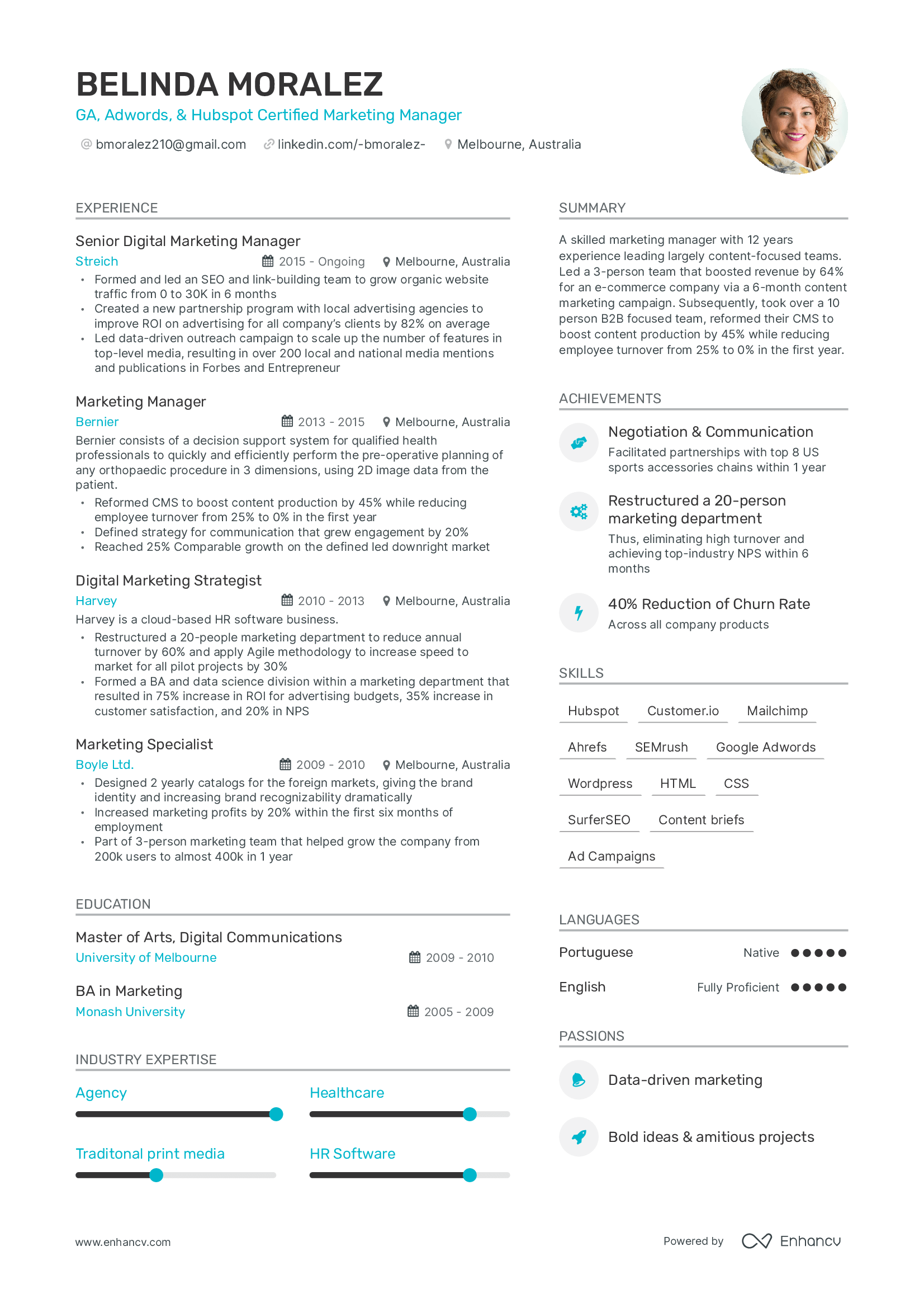
The most popular template for upper management roles, project managers and product owners.
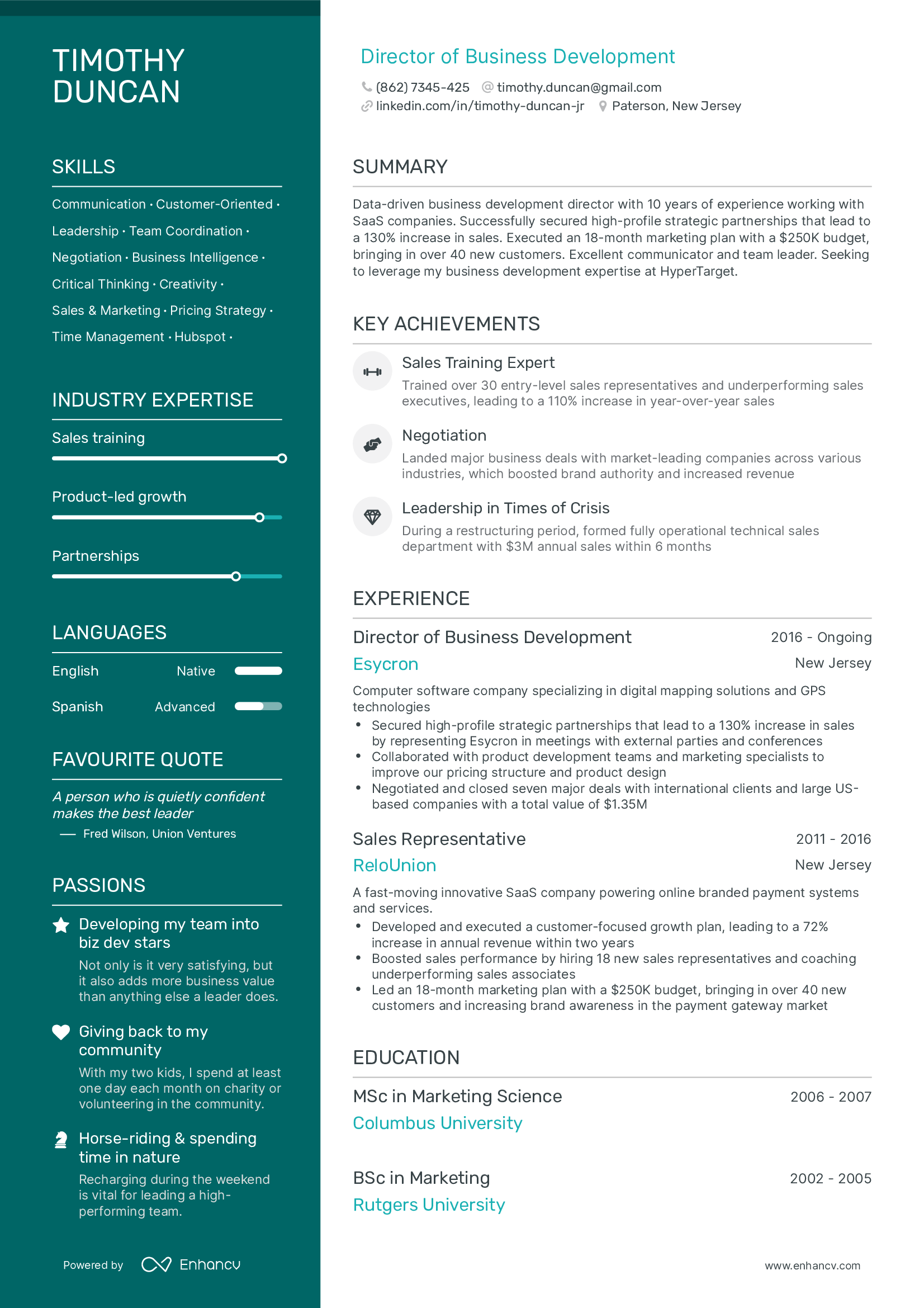
A refined template, especially great for positions where presentation is paramount: business development managers, sales leaders & other customer-facing roles.

A creative template that accents your header and makes recruiters want to read the rest. Built for any industry.

A timeline resume template. Organized neatly with a Timeline to show your career progress. For experienced professionals.

Are you a software engineer or a data scientist with a lot of skills & projects to list on your resume? This template allows you to create a perfect one-page resume.
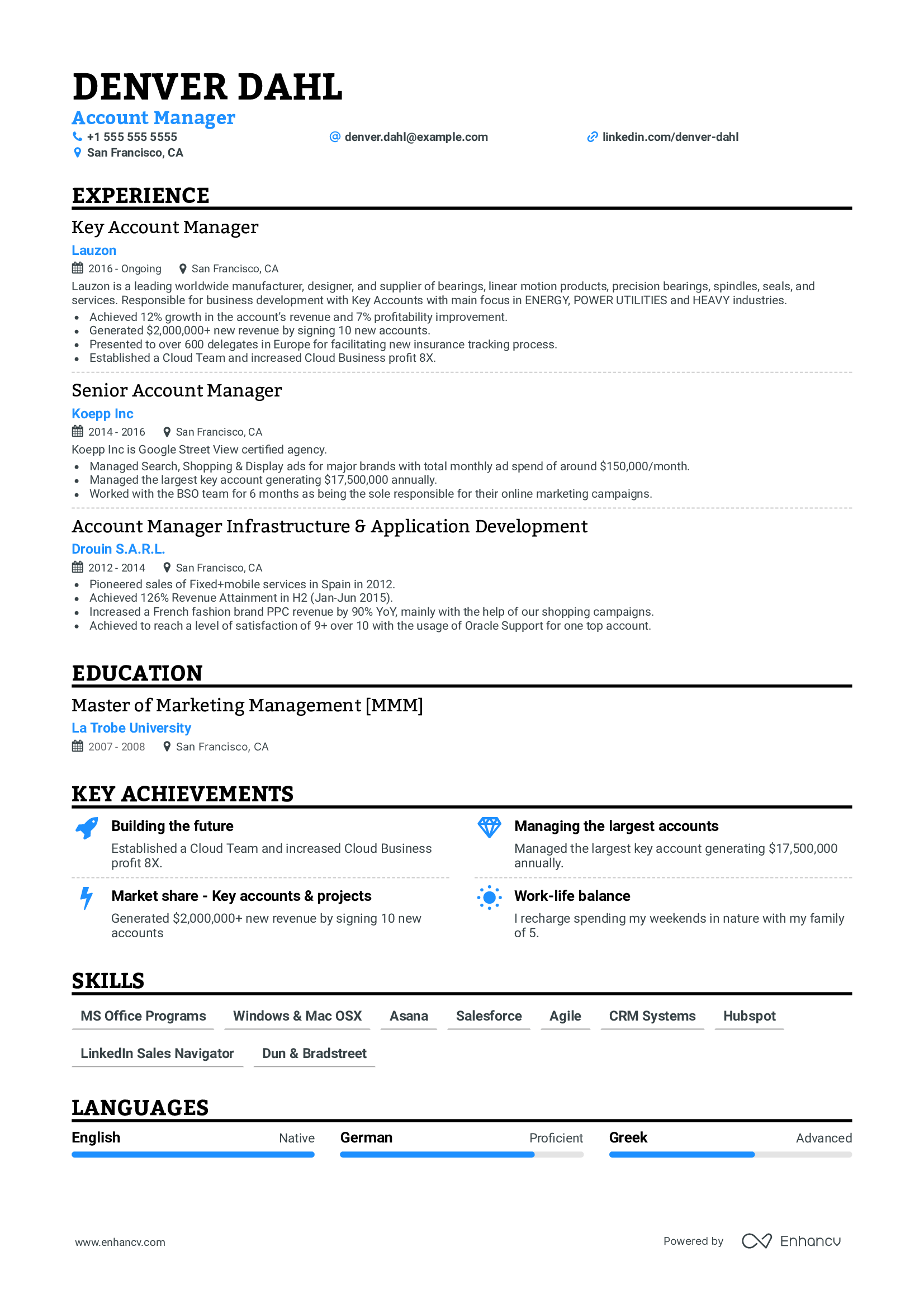
Single Column
Free, simple resume template. Easily readable by both humans and ATS bots.
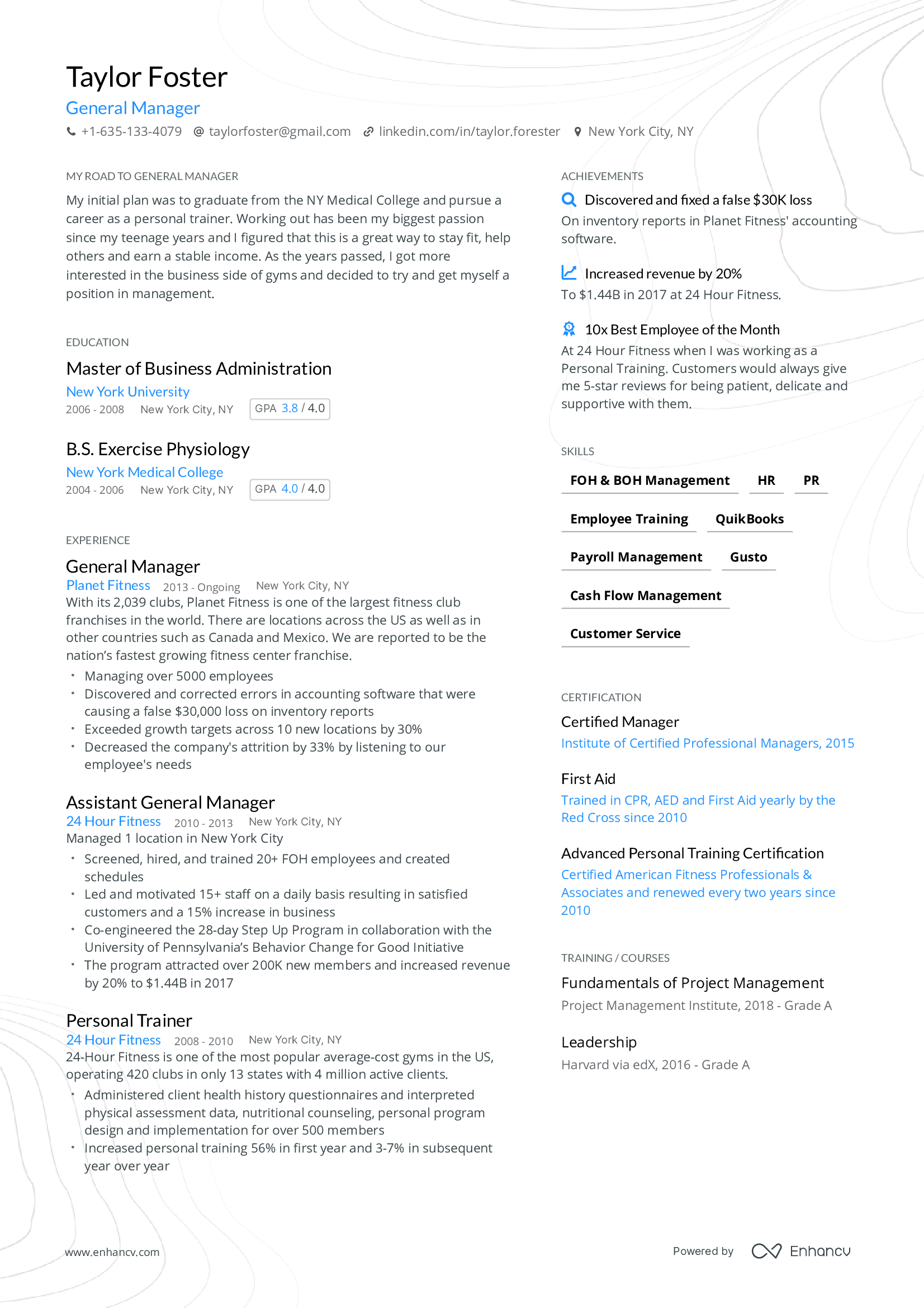
Designed as a one-page resume template for mid-level roles with 3-10 years of experience.
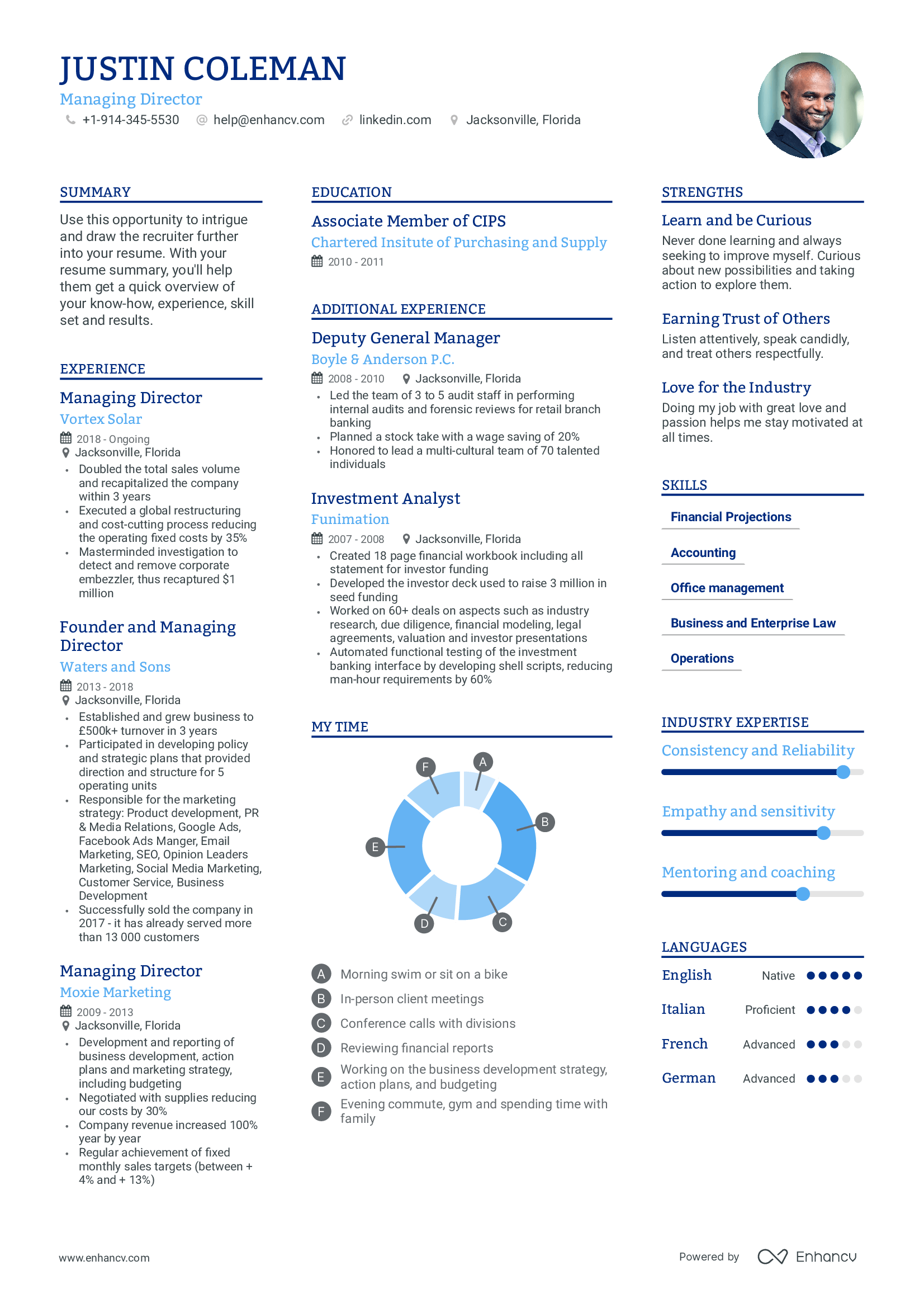
Multicolumn
Multicolumn resume template. Made for executives to fit additional info in a third column.
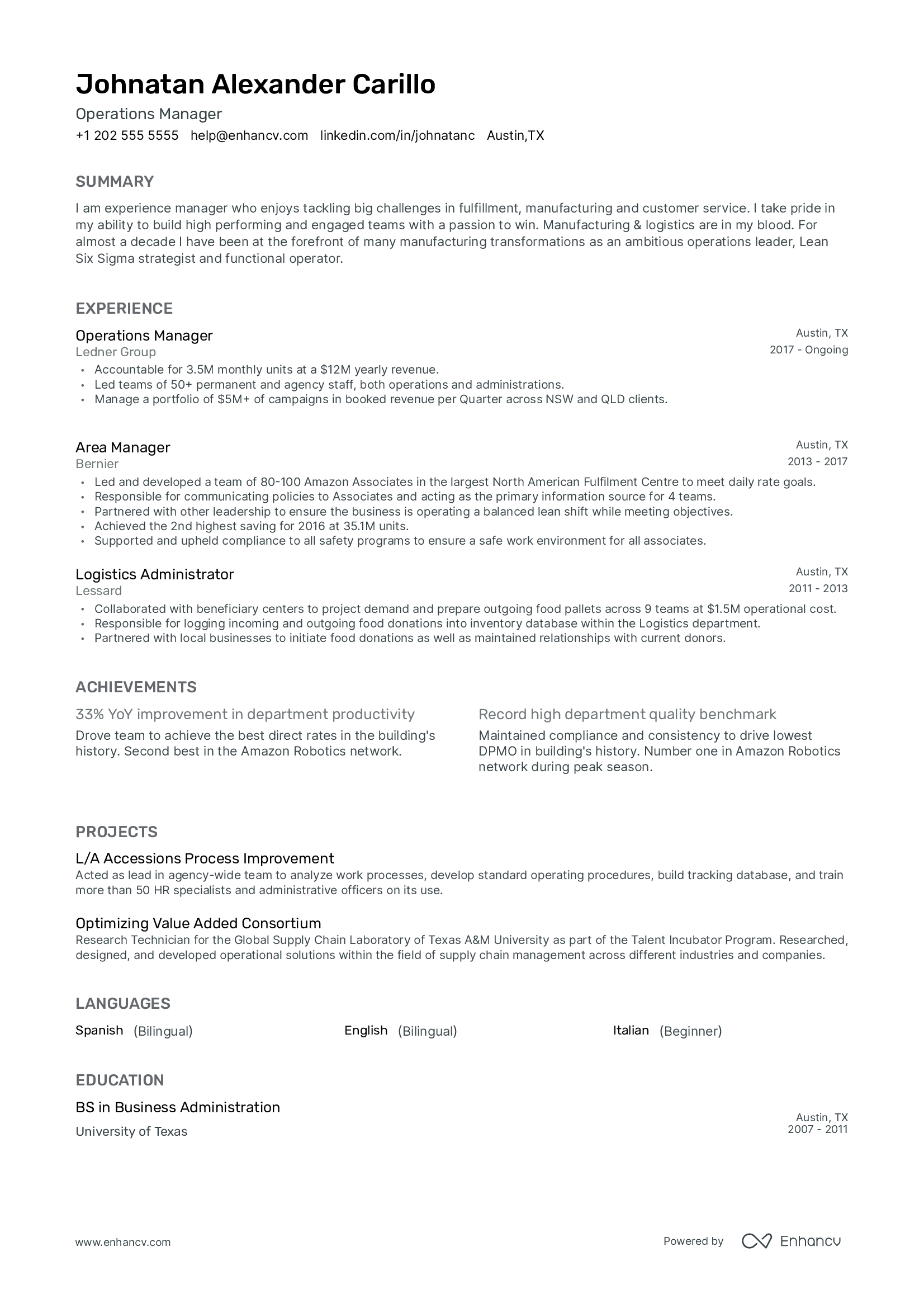
Traditional resume template. Fitting for conservative industries.
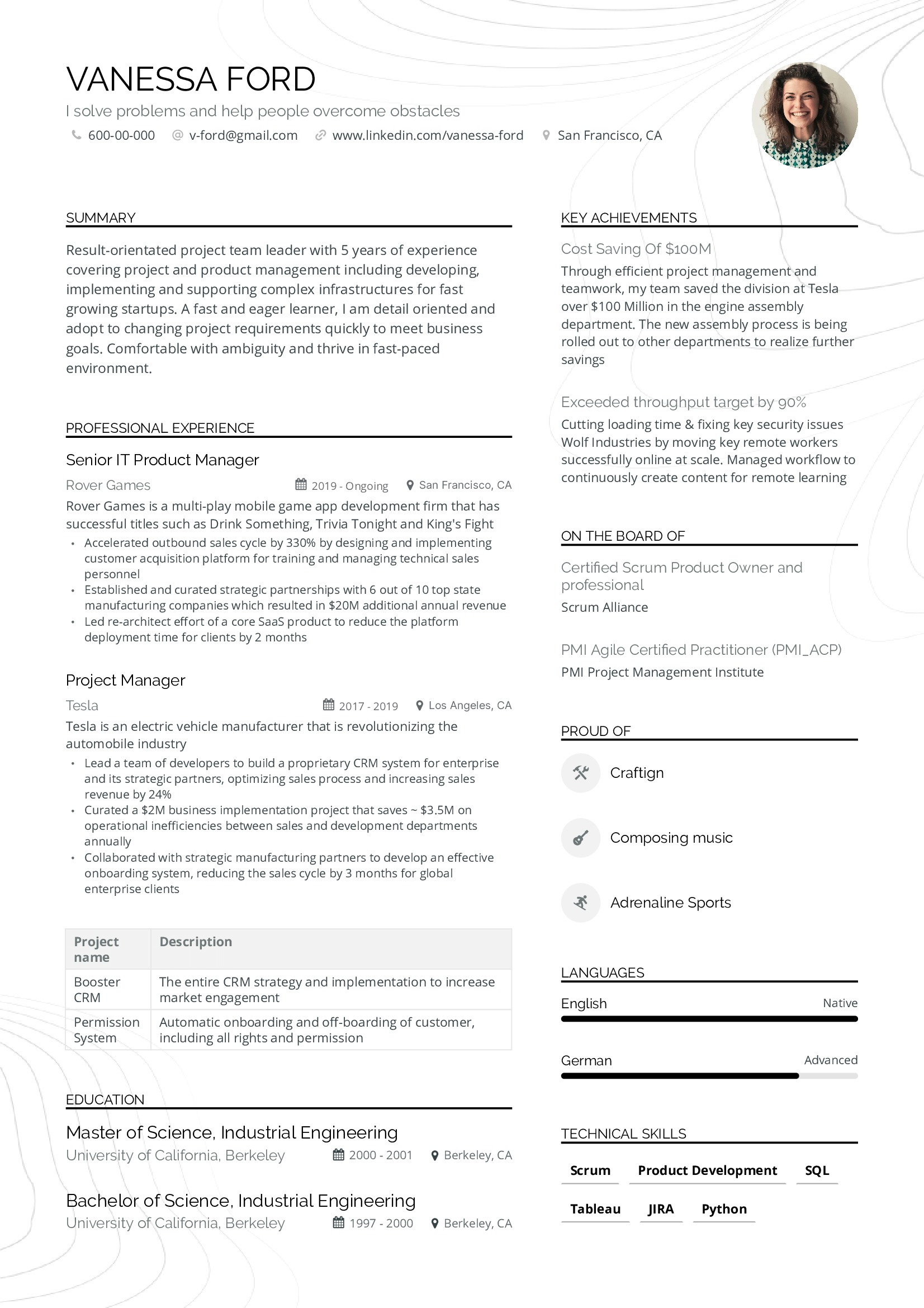
High Performer
Data-focused resume template. Perfect for project and product managers.

Minimalistic resume template. Blends whitespace and content, without clutter.
Resume Templates by job
Unleash the full potential of your career with professionally vetted resume templates. Take a look at samples from real resumes that helped people get hired at top companies in your field, and build a job-winning resume yourself.
Search more resume examples by job
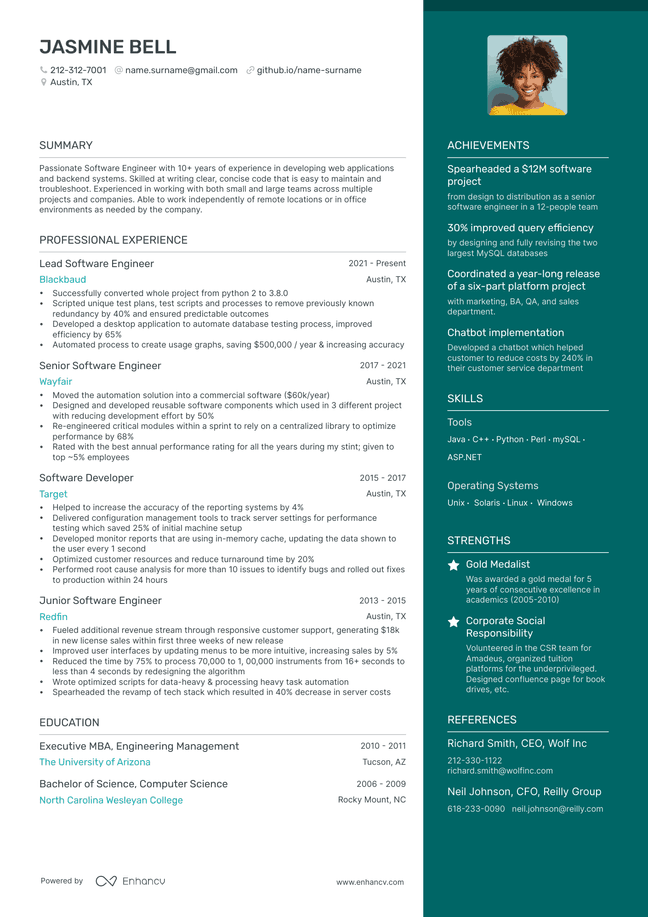
Software Engineer
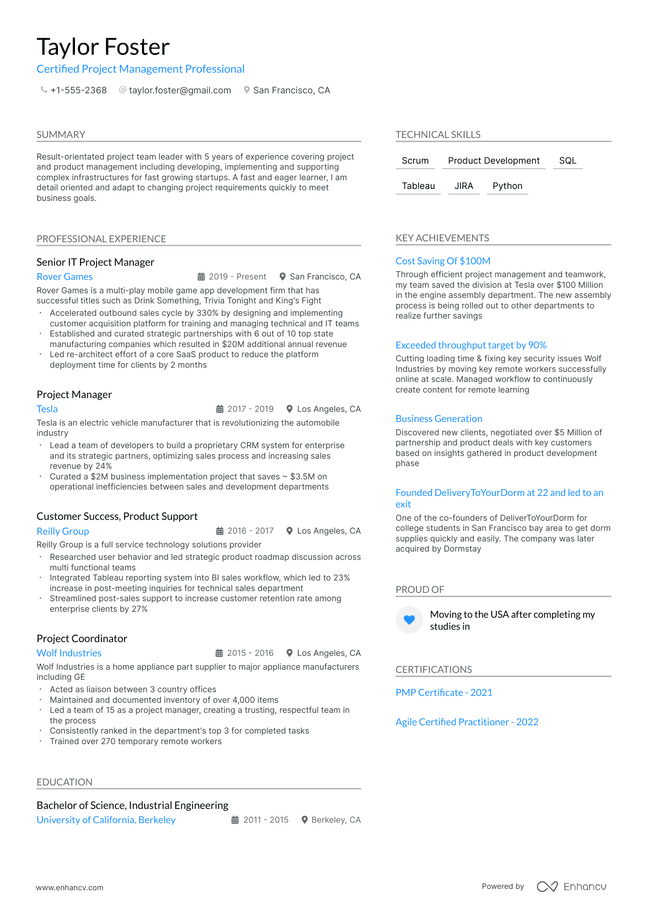
Project Manager

Product Manager

Account Manager
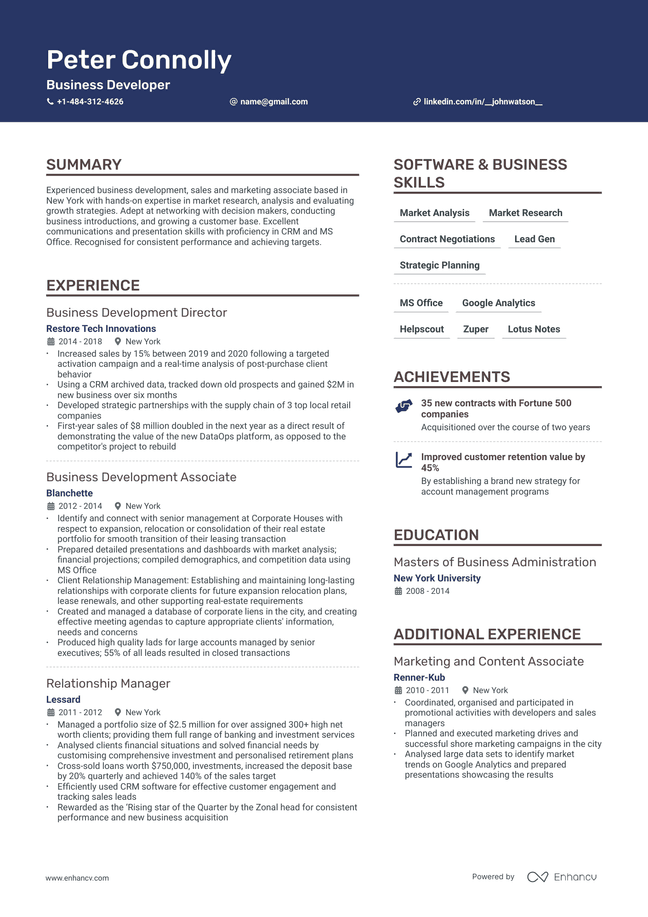
Business Development
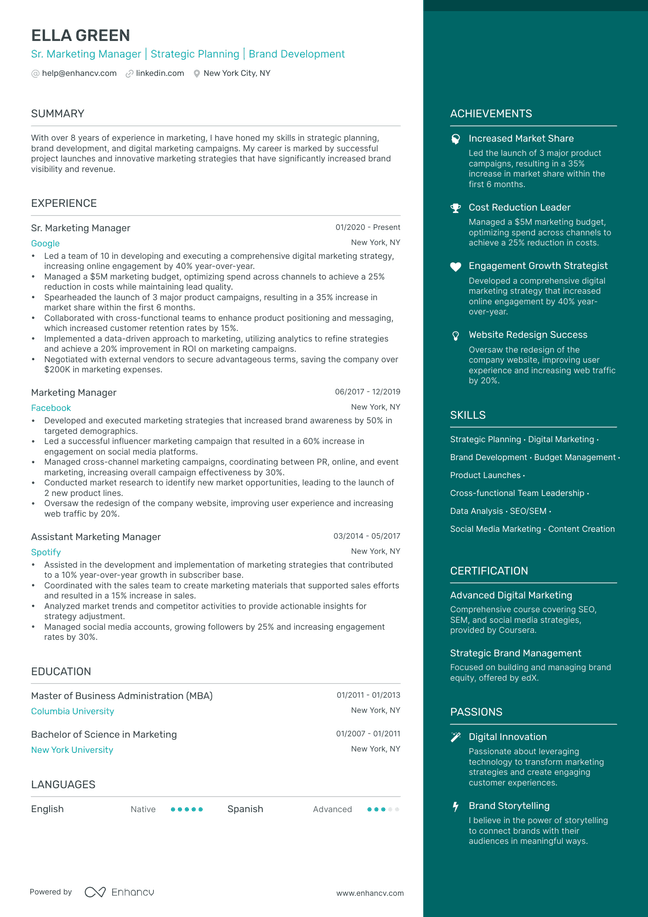
Marketing Manager
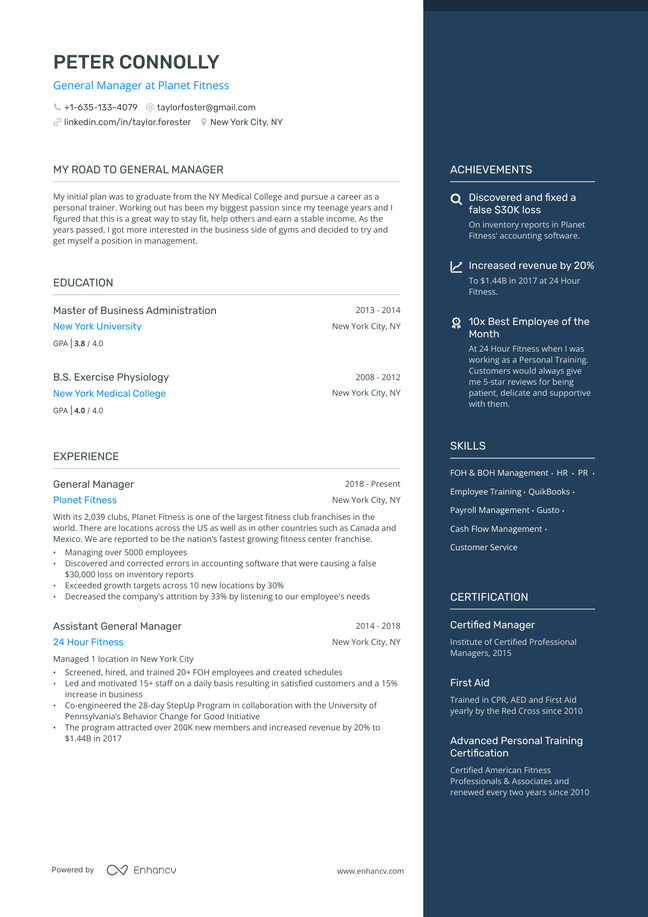
General Manager

Operations Manager

Business Analyst
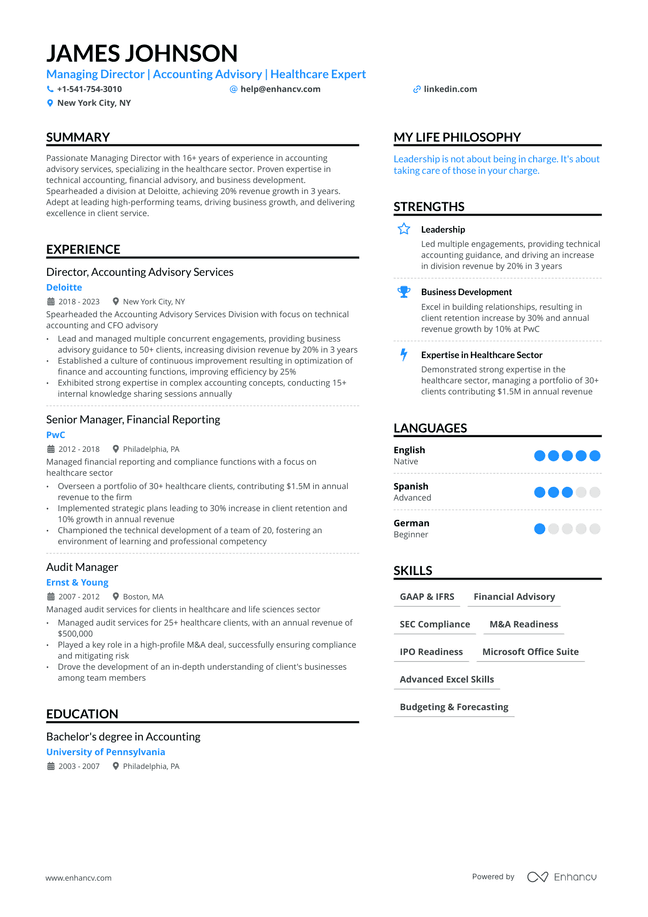
Managing Director
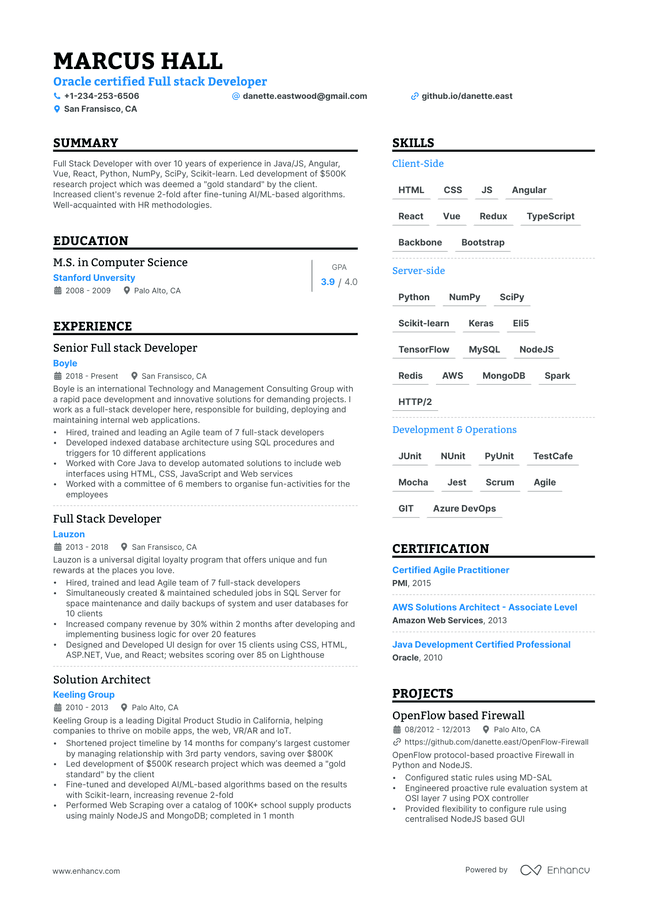
Full-Stack Developer
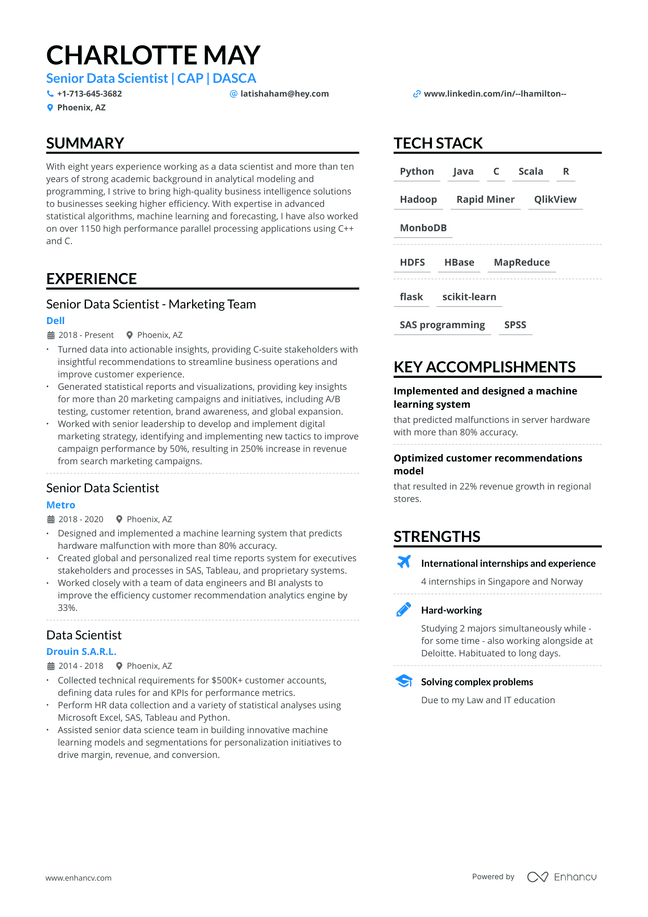
Data Scientist
Resume templates by experience.
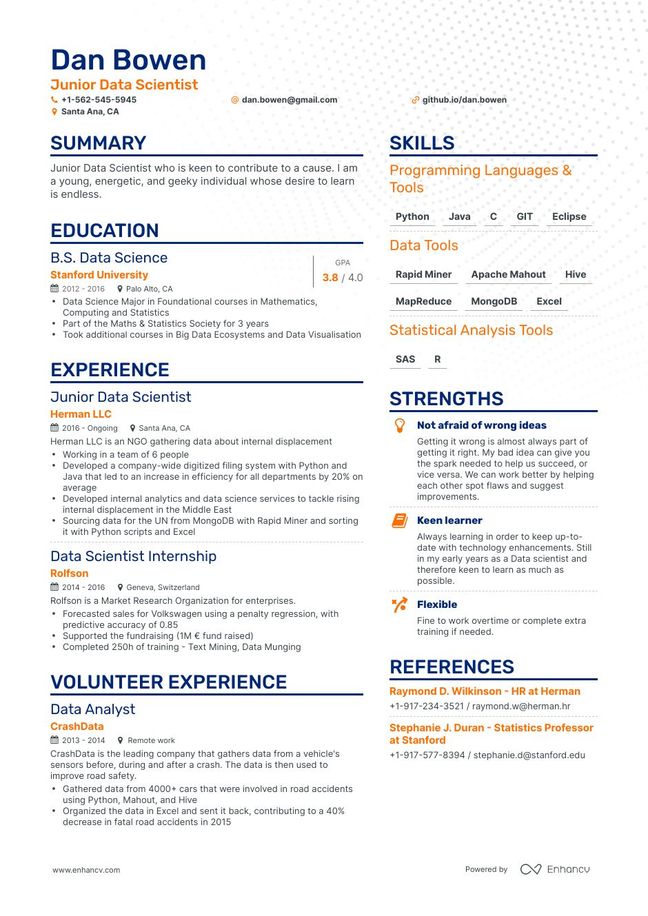
(1-3 years of experience)
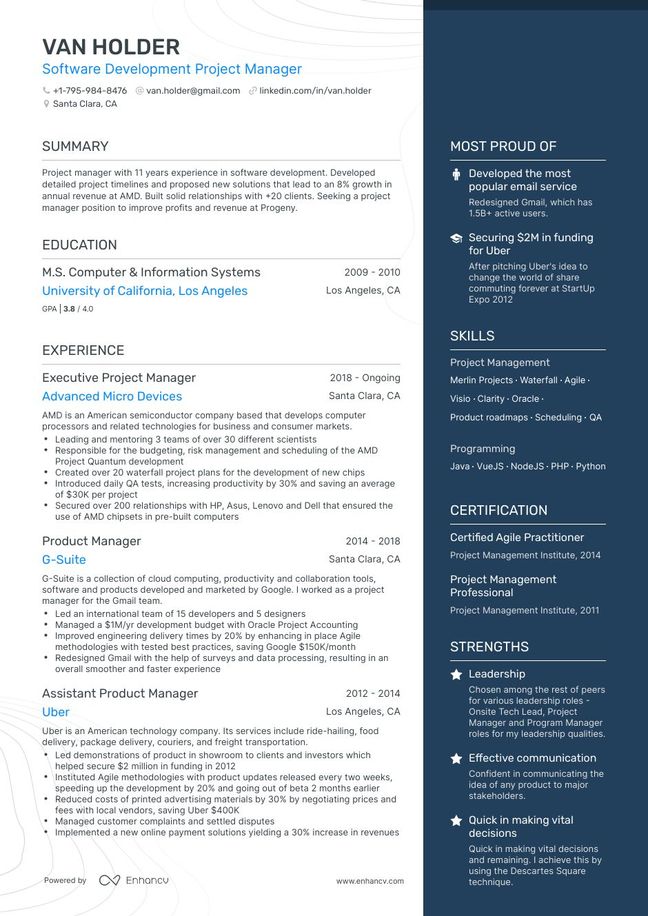
(3-7+ years of experience)
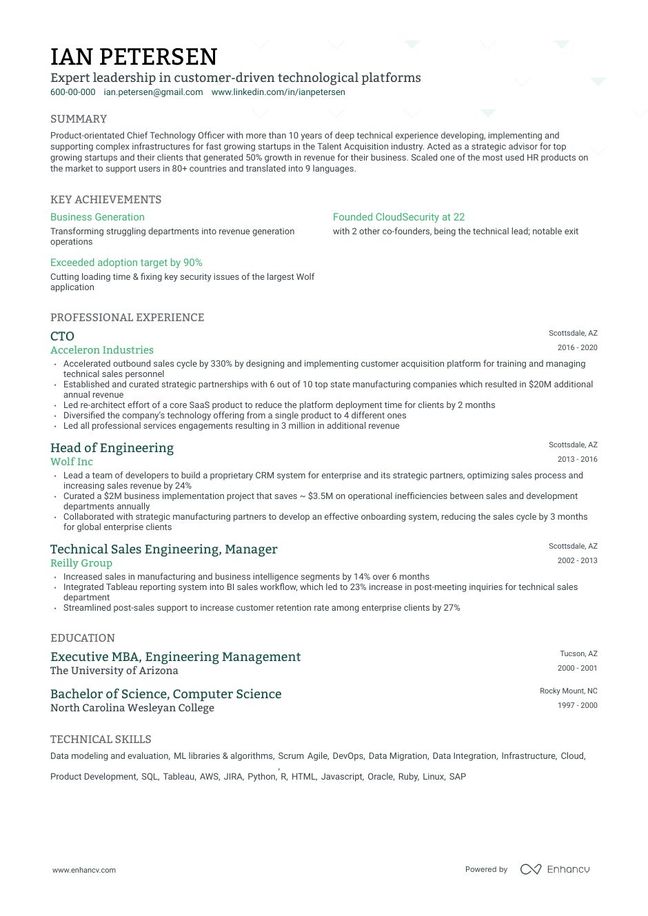
10+ years of experience)
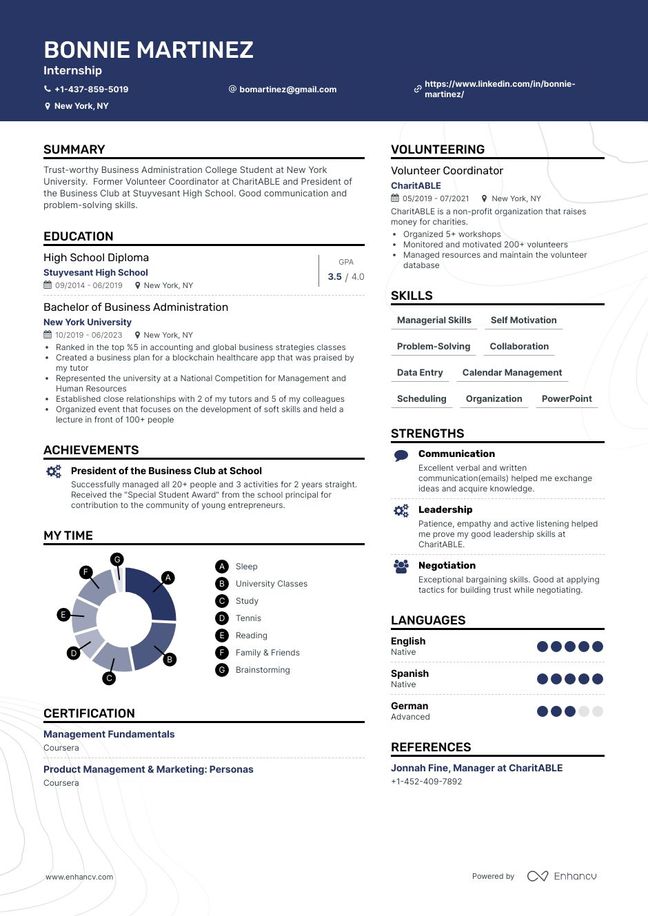
Entry Level
(no prior experience)
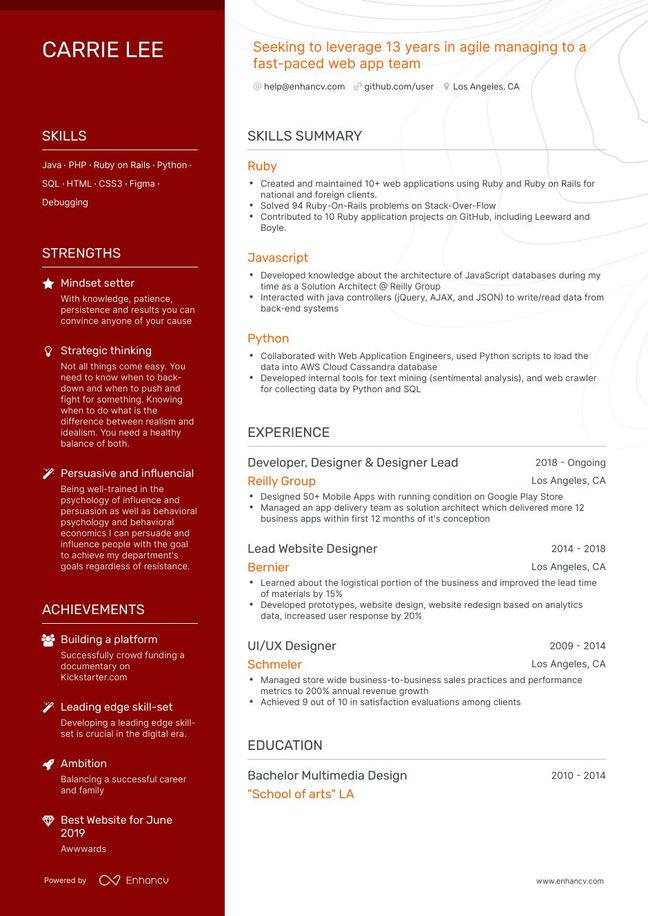
Career Change
Resume templates by format.

Combination Resume Templates

Corporate Resume Templates

Infographic Resume Templates
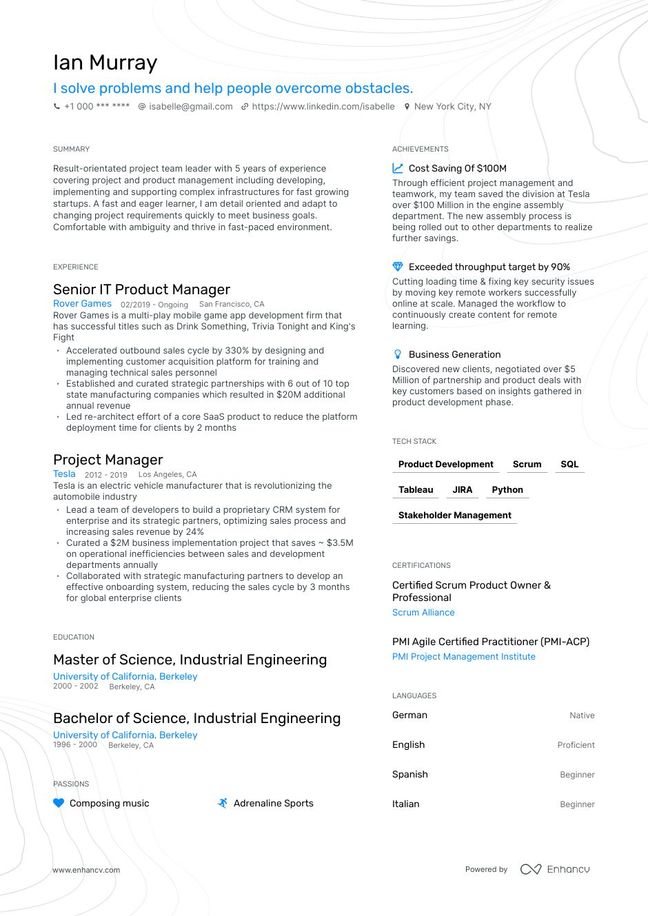
One Page Resume Templates

Timeline Resume Templates

Chronological Resume Templates

Functional Resume Templates

Minimalist Resume Templates

Two Column Resume Templates
- Modern Resume Templates

- Simple Resume Templates
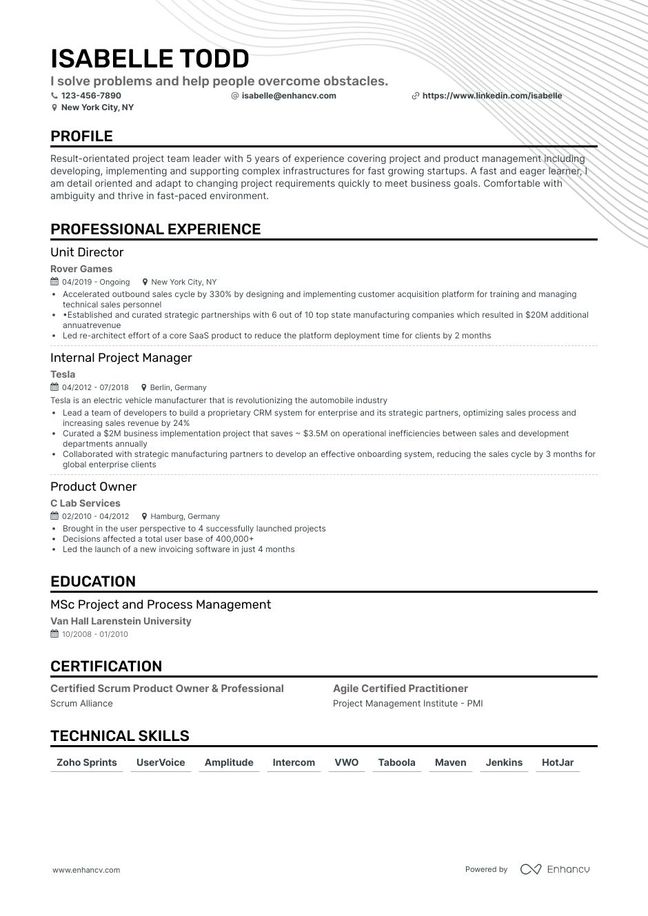
- Create Resume
- Terms of Service
- Privacy Policy
- Cookie Preferences
- Resume Examples
- AI Resume Builder
- Resume Summary Generator
- Resume Formats
- Resume Checker
- Resume Skills
- How to Write a Resume
- Cover Letter Builder
- Cover Letter Examples
- Cover Letter Templates
- Cover Letter Formats
- How to Write a Cover Letter
- Resume Guides
- Cover Letter Guides
- Job Interview Guides
- Job Interview Questions
- Career Resources
- Meet our customers
- Career resources
- English (UK)
- French (FR)
- German (DE)
- Spanish (ES)
- Swedish (SE)
© 2024 . All rights reserved.
Made with love by people who care.
- How to write the perfect CV
A job applicant walks into a bar

Your browser does not support the <audio> element.
I MAGINE MEETING a stranger at a party. What makes for a successful encounter? Lesson one is to heed the wisdom of a shampoo commercial from the 1980s: you never get a second chance to make a first impression. Lesson two is to remember that you do not need to wear a beret or a fur stole in order to stand out. Lesson three is not to forget that what you leave out matters as much as what you say.
These same principles, it turns out, apply to writing a CV . A résumé is not a list of every job you ever had. It is not your autobiography. It is, like that hair-care advert, a marketing tool. Your audience is made up of recruiters and hiring managers. Like cocktail-party guests, they do not take a long time to decide if they want to keep talking. According to one study, such professionals spend an average of 7.4 seconds skimming a job application. Your guest Bartleby has a few tips on how best to ensure that these seconds count.
The CV ’s number-one task is not to put the reader off. If you are thinking of adding a watermark with your initials, think again; you are trying too hard. Use a clean, simple format and avoid fancy fonts (Arial or Helvetica are fine; Century Gothic is not).
Adding colour does not mean using a teal background. Nor does it mean using purple prose. Clichés can be a reason you are passed over for an interview. So can typos; spell-check and proofread over and over. You would be surprised how often someone forgets to include their name and contact details. Dispense with hackneyed descriptors (“cultivated and passionate professional”, “a keen eye for detail”)—facts should speak for themselves. But not all facts. You may think including your ranking on “Overwatch” is a quirky way to illustrate how quick you are on your feet. A recruiter may conclude that it shows you spend hours on the sofa tethered to a gaming console.
Do not hammer your CV out in an hour—take your time to polish it. Condense, filter and distil until what you are left with captures the essence of you. Anyone’s CV can fit on a page, even if you have held residencies in the world’s eight top hospitals or are Christine Lagarde. Forget the personal statement—no one has time for that. If you spent three weeks in the summer when you were 17 keeping the books in your uncle’s hardware store, no one needs to know that if you are now over the age of 25. The older you get, the more you should prioritise work experience over education.
Tailor your résumé for every application by making the relevant tweaks and highlighting different areas. Otherwise you are like the bore who tells the same story to every person he meets. Not everyone—and not every recruiter—is interested in the same things. If you can quantify an accomplishment, do. A second-year law student who just completed his summer internship having worked on six M & A deals? Put that in.
Reasonable gaps in a résumé are not cause for concern. Life happens and sometimes people take time off; you do not have to explain that you spent three months between jobs hiking around Machu Picchu to clear your head and recharge your batteries. A ten-year gap from the workforce may be another matter. So might constant job-switching, which is as much of a red flag to recruiters as admitting to never having had a long-term relationship might be to a stranger at a party. But if this describes your work history then you probably have bigger problems that a CV alone, no matter how masterful, will not fix.
Once you have sent your application, refrain from emailing prospective employers to see if they received it. You risk coming across as that annoying person who texts to see if their previous texts have got through.
In his commencement address at Kenyon College in 2005, David Foster Wallace, an American novelist, used the metaphor of fish oblivious to the element surrounding them in order to point to the dangers of the “natural, hard-wired, default setting which is to be deeply and literally self-centred”. Your life, he implied, should illustrate an acute awareness of the outside world. So should your CV . Drafting a presentation of your skills and achievements will inevitably reflect the sovereignty and self-absorption of your “skull-sized kingdom”, as Wallace described it. So as you launch yourself into the job market, follow his counsel to young graduates to try always to be aware of their place in the greater scheme of things: “This is water…this is water.” ■
Explore more
This article appeared in the Business section of the print edition under the headline “A job applicant walks into a bar”
Business June 1st 2024
- Japanese businesses are trapped between America and China
- Can Elon Musk’s xAI take on OpenAI?
- Can Benetton be patched up?
- ExxonMobil rediscovers its swagger
- The soldiers of the silicon supply chain are worried

From the June 1st 2024 edition
Discover stories from this section and more in the list of contents
More from Business

China’s giant solar industry is in turmoil
Overcapacity has caused prices—and profits—to tumble

A price war breaks out among China’s AI-model builders
It may stymie innovation

The rise of the far right alarms German business leaders
At least, most of them
How Gen Zs rebel against Asia’s rigid corporate culture
Young workers are striking, slouching off and setting sail
What Indian business expects from Modi 3.0
After a brief panic, investors and bosses welcome the new government
The EU hits China’s carmakers with hefty new tariffs
Duties will only hold them back for a while
Purdue Online Writing Lab Purdue OWL® College of Liberal Arts
Welcome to the Purdue Online Writing Lab

Welcome to the Purdue OWL
This page is brought to you by the OWL at Purdue University. When printing this page, you must include the entire legal notice.
Copyright ©1995-2018 by The Writing Lab & The OWL at Purdue and Purdue University. All rights reserved. This material may not be published, reproduced, broadcast, rewritten, or redistributed without permission. Use of this site constitutes acceptance of our terms and conditions of fair use.
The Online Writing Lab (the Purdue OWL) at Purdue University houses writing resources and instructional material, and we provide these as a free service at Purdue. Students, members of the community, and users worldwide will find information to assist with many writing projects. Teachers and trainers may use this material for in-class and out-of-class instruction.
The On-Campus and Online versions of Purdue OWL assist clients in their development as writers—no matter what their skill level—with on-campus consultations, online participation, and community engagement. The Purdue OWL serves the Purdue West Lafayette and Indianapolis campuses and coordinates with local literacy initiatives. The Purdue OWL offers global support through online reference materials and services.
Social Media
Facebook twitter.

An official website of the United States government
Here's how you know
Official websites use .gov A .gov website belongs to an official government organization in the United States.
Secure .gov websites use HTTPS A lock ( Lock Locked padlock ) or https:// means you've safely connected to the .gov website. Share sensitive information only on official, secure websites.
How to complete any task on USAJOBS, step by step.
Manage Account
- Create a login.gov account
- Use login.gov if you have limited access to a phone or cell service
- Change the phone number you use to sign in
- Enter an international phone number when creating a login.gov account
- Update your primary email address
- Change or reset your password
- Sign into your account if you can't access your primary email
- Create a profile
- Delete a profile
- Fill out your education
- Answer questions about federal service
- Choose hiring paths in your profile
- Add languages in your profile
- Answer questions about military service
- Fill out your work experience
- Make your resume and profile searchable
Job announcement
- Understand a job announcement
- Understand announcement closing types
- Save a job announcement
- Remove a saved job announcement
- Contact an agency
Application
- Create an application
- Save an application
- Update an application
- Continue an application
- Check on the status of an application
- Archive an application
- Cancel an application
- View job applications
- Create a resume
- Build a resume
- Edit a resume
- Upload a resume
- Make a resume searchable
- Print a resume
- Upload documents
- Manage documents
- Fax documents
- Search by your preferences
- Save a search
- Sort search results
- Understand search results
- Unsubscribe from a saved search
Filter results by...
- Appointment type
- Hiring path
- Mission critical career field
- Security clearance
- Travel percentage
- Work schedule
- Zero job openings
Keyword and location
Get started.
USAJOBS posts all federal job opportunities with a position description and instructions how to apply. With USAJOBS.gov tools and resources, you can find the right federal job faster.
About USAJOBS
As the federal government's official employment site, USAJOBS has attracted over 16 million job seekers to create accounts to date.

COMMENTS
Create Resume. Choose a resume format carefully. In 99% of cases, we recommend the reverse-chronological format. Add the right contact details. Leave your headshot out and make sure to include your job title, a professional email address, and any relevant links.
3. List your name and contact information. To start writing your resume, create an eye-catching resume header that quickly highlights your contact information and job title. Your name should always be the largest element on your resume to make it stand out, so use a font size larger than 20 points.
See this guide for the best resume examples and resume-writing rules, and create yours in a few easy steps. Tools. Resume Builder Create a resume in 5 minutes. Get the job you want. ... Use present tense to describe current job and past tense to discuss previous experience. Key achievements: Often overlooked but super important. Employers know ...
Related: 10 Resume Writing Tips to Help You Land a Job Tenses to use on resumes You will find two different tenses on a resume: Present tense Verbs that are in the present tense refer to tasks that are current and ongoing, either something that you do repeatedly in the job or something you're currently doing. Past tense Verbs that are written ...
Writing a great resume is a crucial step in your job search. If you're looking for a well-written example resume for inspiration, we have a selection of resume samples to get you started. We've put together a collection of resume examples for a variety of industries and job titles with recommended skills and common certifications.
5. Don't Forget Your Education. If you're still in school or just graduated, your education can go at the top of your resume, but for pretty much everyone else, this goes near the bottom. Most people include their school, graduation year (for folks less up to about a decade out of school), major, and degree.
Sample resumes for every industry and job & writing tips + copy-paste templates. Download for free. Over 430 HR-approved resume examples. Sample resumes for every industry and job & writing tips + copy-paste templates. ... Current CPRWs on the team include Geoff Scott, Samuel Johns, Eva Chan, Corissa Peterson, and Aaron Case.
Focus on your resume as a summary of your qualifications and experience for the job you are applying for. Use an easily readable standard font with formatting that takes advantage of white space and bullet points. Proofread carefully. Make sure you do not have spelling or grammatical errors and your content is written clearly and concisely.
Use our industrial-strength resume templates to get you on your way to manufacturing a winning resume. Amazon. Assembly Line Worker. Factory Worker. Heavy Equipment Operator. Inventory Manager. Logistics Coordinator. Logistics Manager. Machine Operator.
Web Developer Resume Example 65+ More Resume Examples and Guides 5+ Examples of Resume Templates #1. Traditional Resume #2. Creative Resume #3. Minimalist Resume #4. Basic Resume #5. IT Resume #6. Modern Resume #7. General Resume 5+ Resume Examples by Career Level #1. No Experience Resume #2.
15. Engineering is complex. Creating an amazing engineering resume can be easy! Use our field-tested resume examples: get inspired, edit and build your own in minutes. Save time and boost your chances of landing a great job as an electrical, civil, or mechanical engineer today. Civil Engineer. Electrical Engineer.
If your resume headline has a verb or if there are any activities, volunteer work, or projects you're currently working on outside of a full-time job, those should use the present tense as well. Basically, if the date range ends with "Present," that's a good indicator you should be using the present tense, Smith says.
Here's some resume tips and tricks for this section: 21. Put experience first, education later. Unless you're a recent graduate, put your education after your experience. Chances are, your last couple of jobs are more important and relevant to you getting the job than where you went to college. 22.
3. Write your resume sections. Guided by your keyword list and format, you're ready to start filling out your resume sections. You'll typically want to include sections for your header, work experience, education, and skills, but there are optional sections you can add to amplify the story you want to tell.
In this case, it's appropriate to write in the present tense on your resume when discussing your current job. For example, if you're currently mentoring interns or collaborating with other teams, it's acceptable to write that in the present tense. This means that, regardless of what you were taught in high school English, it's okay to mix ...
Here are six current resume trends to follow in 2024: 1. Resumes are becoming more skills-focused. Rapid technological advancement and the resulting transformation of skills requirements in tech jobs have resulted in a widening digital skills gap. As a result, employers are changing their recruitment strategies.
The aim of a resume is to get invited to a job interview. It should aim to convince an employer that you're a good fit for the job. Because of that, your resume should be adjusted and tailored to each job vacancy. TL;DR Here's a step-by-step video guide on how to write a professional resume in 2024
Related: Resume samples and templates to inspire your next application. 2. Include your name and contact information. Your resume should begin with your name and contact information, including your professional email address and phone number. You have a choice about whether or not to include your mailing address.
Products. Resume Score Score your resume in seconds; Resume Bullet Points Generator Generate tailored statements about your skills; AI Resume Tool Use AI to create your best resume.; Job Tracker Board Track and manage your job applications and interviews.; Jobs Get your personalized job listings directly within Jobscan.; Resume Power Edit Edit your resume with AI-powered software.
Pick a resume template, add ready content created by certified resume writers, and download in TXT, DOC, or PDF. Tools. Resume Builder Create a resume in 5 minutes. Get the job you want. ... starting with your current or most recent job. Analyze the job ad to identify resume keywords your future employer is looking for. That could be industry ...
Name: Include your first and last name. Phone number: The best option is your cellphone number so recruiters can reach you easily. Email: Make sure it's appropriate, simple and free of nicknames. Unprofessional email addresses comprise 35% of the most common resume mistakes — which we discuss further down the page.
A resume summary is a short section at the top of your resume that highlights your most relevant skills and achievements related to the job. In 2-3 simple sentences, a good resume summary tells the hiring manager: Your years of experience in that type of role. Your top qualifications or impressive accomplishments.
Here is the way to remember tense selection for a current job. Always write about the scope of your responsibility and major job functions in an overview paragraph. Write those things in present tense because they are ongoing. Next, create a bulleted list of accomplishments. Because accomplishments have been accomplished, the items in the ...
A professional resume template is a job-application document that outlines your work history, education, skills, and professional achievements, and shows why you're the best candidate for the job. Enhancv's resume builder is customizable and easy to adapt to any field or experience. Our 1000 design combinations will ensure you can build a ...
Pro tip: Left-align all the text on your resume since it's the easiest format for reviewers to read. If you prefer, you can center-align your name, contact information and headline. If you do choose to center-align any text, this is the only section that should be considered. 2. Select a professional, readable font.
If you are currently employed, the dates on your resume for your current job should end with "present.". For instance: Chocolate Teapot Maker, 2009 - present. not. Chocolate Teapot Maker, 2009 - 2013. If you do the latter, many of us will wonder if you're still employed there or whether you left.
The CV's number-one task is not to put the reader off.If you are thinking of adding a watermark with your initials, think again; you are trying too hard. Use a clean, simple format and avoid ...
The Online Writing Lab (the Purdue OWL) at Purdue University houses writing resources and instructional material, and we provide these as a free service at Purdue. Students, members of the community, and users worldwide will find information to assist with many writing projects.
The following section reviews two areas in which it is common to use the present tense in your resume as well as many examples for both. 1. Objective statement or resume summary. Your objective statement (used for those who are new to the job field) or resume summary (used for those with previous industry experience) is the first instance where ...
Resume. Create a resume; Build a resume; Edit a resume; Upload a resume; Make a resume searchable; Print a resume; Documents. Upload documents; Manage documents; ... description and instructions how to apply. With USAJOBS.gov tools and resources, you can find the right federal job faster. Get started. About USAJOBS. As the federal government's ...